Theories, Principles and Models in Education and Training
VerifiedAdded on 2023/06/08
|20
|6792
|376
AI Summary
This report analyzes the different theories, principles and models in education and training and how they can be applied to teaching, learning and assessment. It covers the analysis of models of learning preferences and communication theories. It also explains how identifying and taking account of learners’ individual learning preferences enables inclusive teaching, learning and assessment. The report is focused on Physical education & training teacher specialization area.
Contribute Materials
Your contribution can guide someone’s learning journey. Share your
documents today.
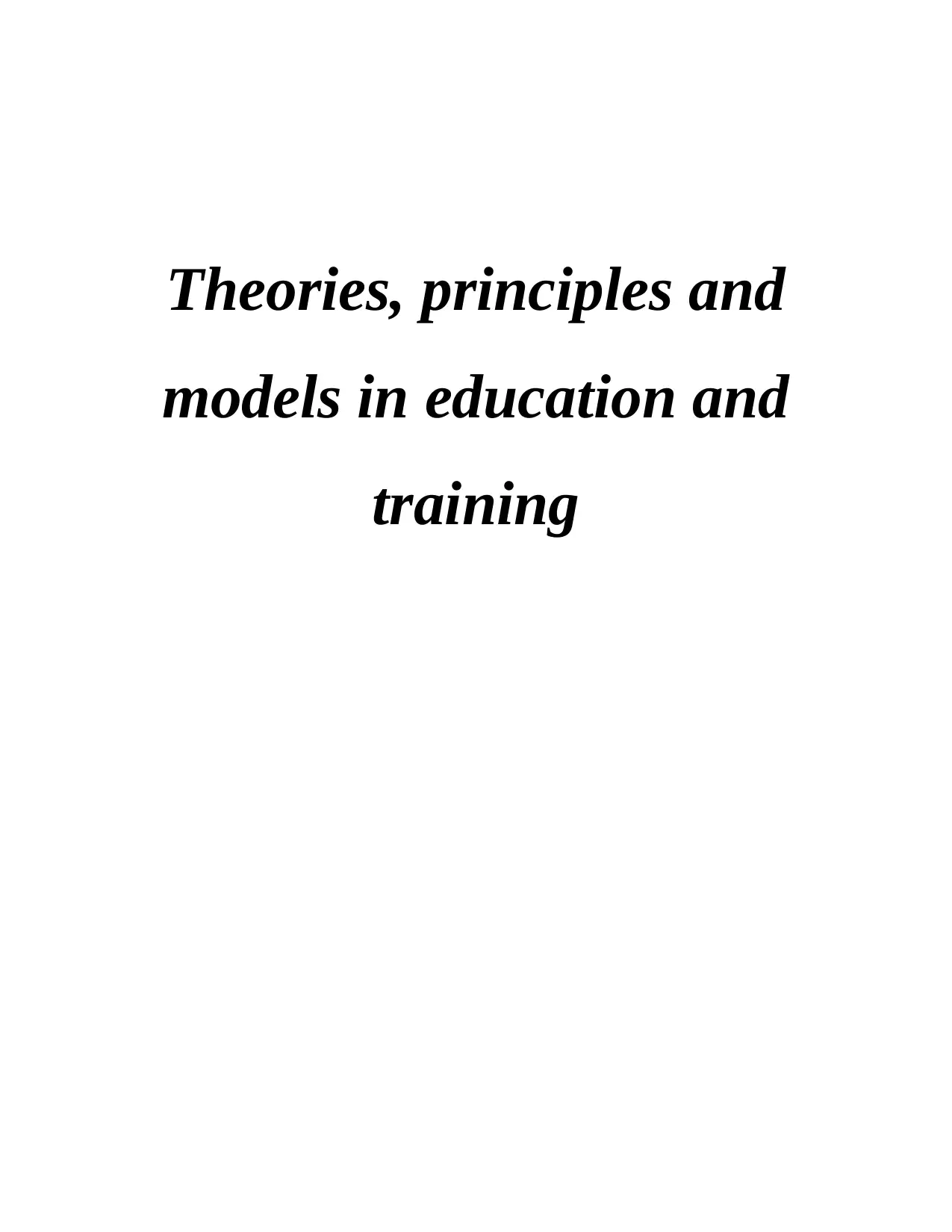
Theories, principles and
models in education and
training
models in education and
training
Secure Best Marks with AI Grader
Need help grading? Try our AI Grader for instant feedback on your assignments.
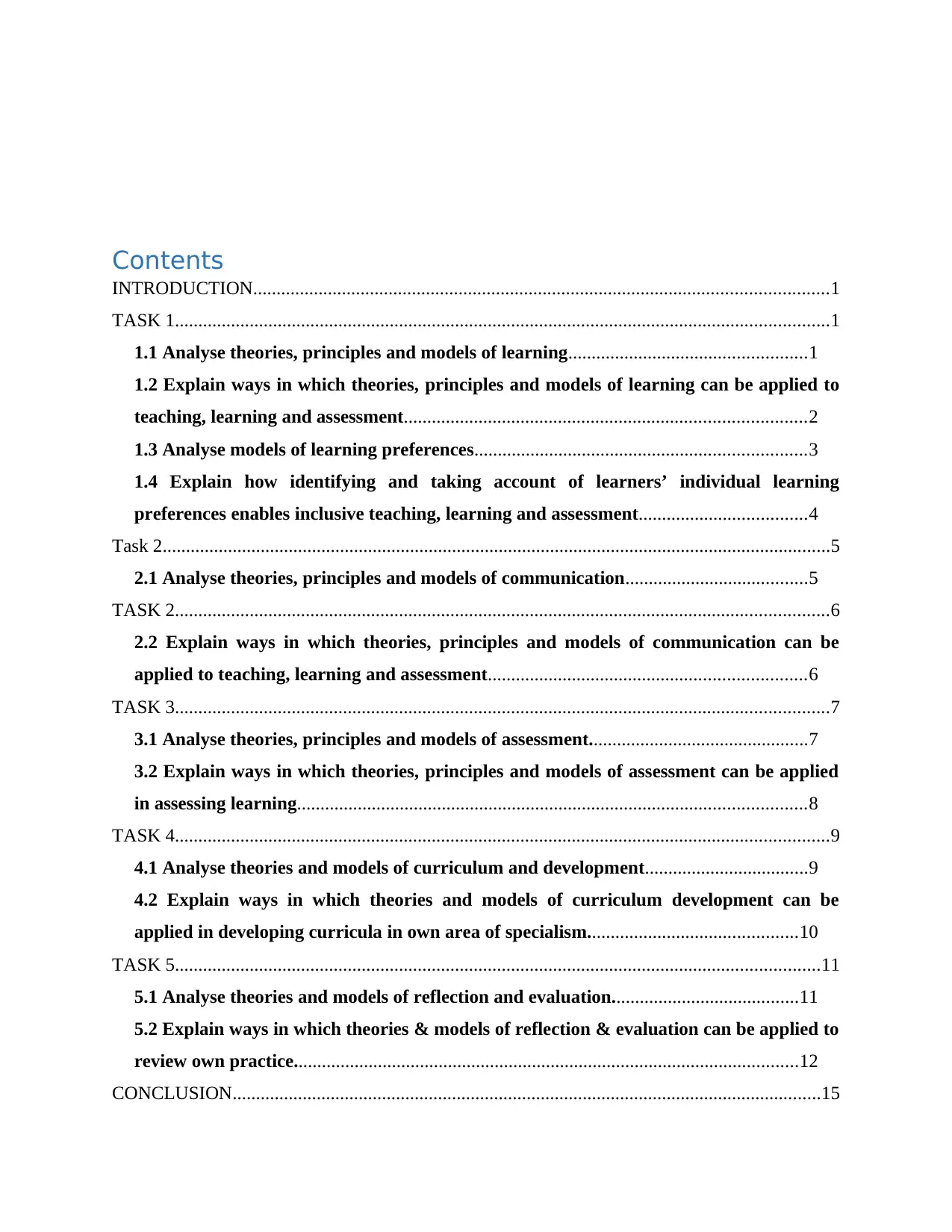
Contents
INTRODUCTION...........................................................................................................................1
TASK 1............................................................................................................................................1
1.1 Analyse theories, principles and models of learning...................................................1
1.2 Explain ways in which theories, principles and models of learning can be applied to
teaching, learning and assessment......................................................................................2
1.3 Analyse models of learning preferences.......................................................................3
1.4 Explain how identifying and taking account of learners’ individual learning
preferences enables inclusive teaching, learning and assessment....................................4
Task 2...............................................................................................................................................5
2.1 Analyse theories, principles and models of communication.......................................5
TASK 2............................................................................................................................................6
2.2 Explain ways in which theories, principles and models of communication can be
applied to teaching, learning and assessment....................................................................6
TASK 3............................................................................................................................................7
3.1 Analyse theories, principles and models of assessment...............................................7
3.2 Explain ways in which theories, principles and models of assessment can be applied
in assessing learning.............................................................................................................8
TASK 4............................................................................................................................................9
4.1 Analyse theories and models of curriculum and development...................................9
4.2 Explain ways in which theories and models of curriculum development can be
applied in developing curricula in own area of specialism.............................................10
TASK 5..........................................................................................................................................11
5.1 Analyse theories and models of reflection and evaluation........................................11
5.2 Explain ways in which theories & models of reflection & evaluation can be applied to
review own practice............................................................................................................12
CONCLUSION..............................................................................................................................15
INTRODUCTION...........................................................................................................................1
TASK 1............................................................................................................................................1
1.1 Analyse theories, principles and models of learning...................................................1
1.2 Explain ways in which theories, principles and models of learning can be applied to
teaching, learning and assessment......................................................................................2
1.3 Analyse models of learning preferences.......................................................................3
1.4 Explain how identifying and taking account of learners’ individual learning
preferences enables inclusive teaching, learning and assessment....................................4
Task 2...............................................................................................................................................5
2.1 Analyse theories, principles and models of communication.......................................5
TASK 2............................................................................................................................................6
2.2 Explain ways in which theories, principles and models of communication can be
applied to teaching, learning and assessment....................................................................6
TASK 3............................................................................................................................................7
3.1 Analyse theories, principles and models of assessment...............................................7
3.2 Explain ways in which theories, principles and models of assessment can be applied
in assessing learning.............................................................................................................8
TASK 4............................................................................................................................................9
4.1 Analyse theories and models of curriculum and development...................................9
4.2 Explain ways in which theories and models of curriculum development can be
applied in developing curricula in own area of specialism.............................................10
TASK 5..........................................................................................................................................11
5.1 Analyse theories and models of reflection and evaluation........................................11
5.2 Explain ways in which theories & models of reflection & evaluation can be applied to
review own practice............................................................................................................12
CONCLUSION..............................................................................................................................15

References:.....................................................................................................................................16
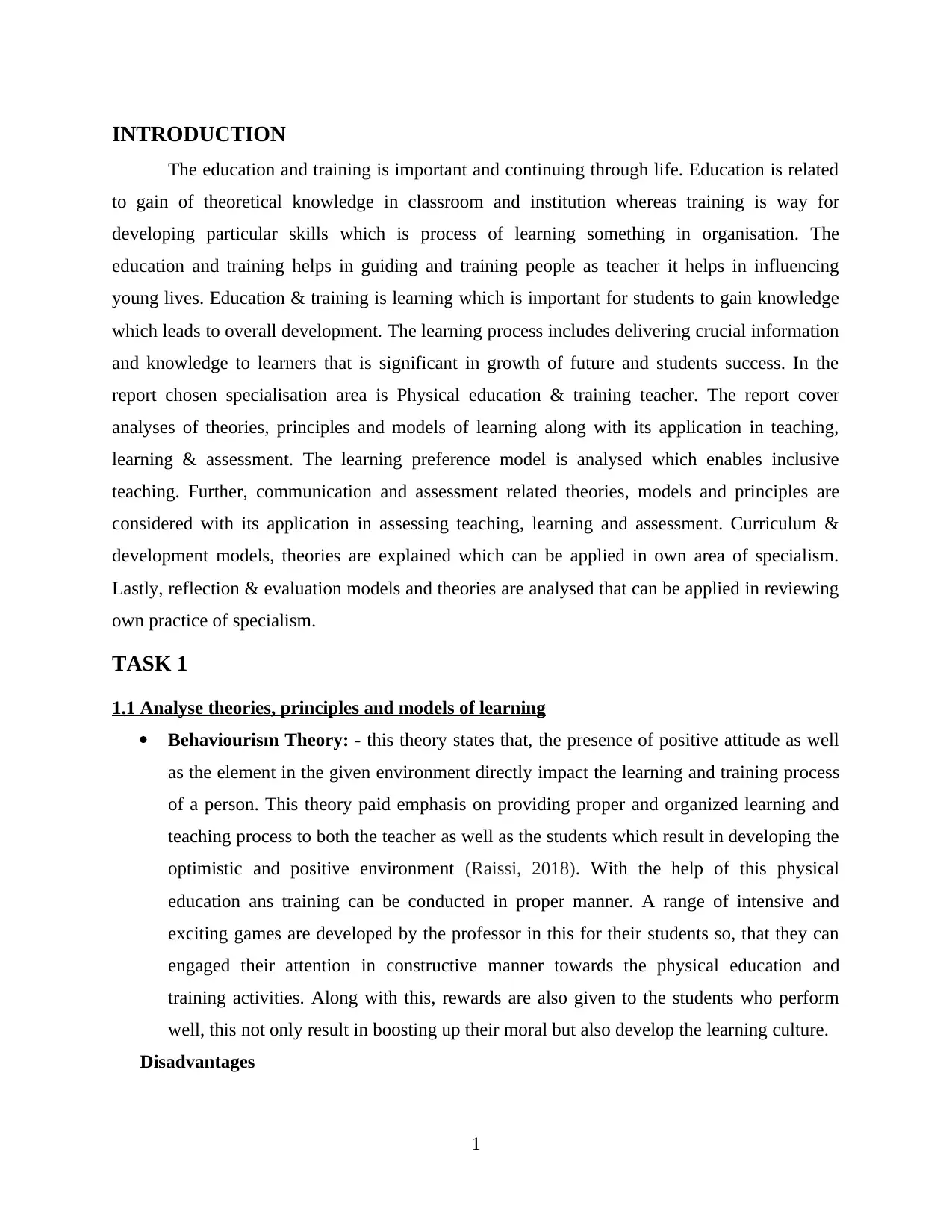
INTRODUCTION
The education and training is important and continuing through life. Education is related
to gain of theoretical knowledge in classroom and institution whereas training is way for
developing particular skills which is process of learning something in organisation. The
education and training helps in guiding and training people as teacher it helps in influencing
young lives. Education & training is learning which is important for students to gain knowledge
which leads to overall development. The learning process includes delivering crucial information
and knowledge to learners that is significant in growth of future and students success. In the
report chosen specialisation area is Physical education & training teacher. The report cover
analyses of theories, principles and models of learning along with its application in teaching,
learning & assessment. The learning preference model is analysed which enables inclusive
teaching. Further, communication and assessment related theories, models and principles are
considered with its application in assessing teaching, learning and assessment. Curriculum &
development models, theories are explained which can be applied in own area of specialism.
Lastly, reflection & evaluation models and theories are analysed that can be applied in reviewing
own practice of specialism.
TASK 1
1.1 Analyse theories, principles and models of learning
Behaviourism Theory: - this theory states that, the presence of positive attitude as well
as the element in the given environment directly impact the learning and training process
of a person. This theory paid emphasis on providing proper and organized learning and
teaching process to both the teacher as well as the students which result in developing the
optimistic and positive environment (Raissi, 2018). With the help of this physical
education ans training can be conducted in proper manner. A range of intensive and
exciting games are developed by the professor in this for their students so, that they can
engaged their attention in constructive manner towards the physical education and
training activities. Along with this, rewards are also given to the students who perform
well, this not only result in boosting up their moral but also develop the learning culture.
Disadvantages
1
The education and training is important and continuing through life. Education is related
to gain of theoretical knowledge in classroom and institution whereas training is way for
developing particular skills which is process of learning something in organisation. The
education and training helps in guiding and training people as teacher it helps in influencing
young lives. Education & training is learning which is important for students to gain knowledge
which leads to overall development. The learning process includes delivering crucial information
and knowledge to learners that is significant in growth of future and students success. In the
report chosen specialisation area is Physical education & training teacher. The report cover
analyses of theories, principles and models of learning along with its application in teaching,
learning & assessment. The learning preference model is analysed which enables inclusive
teaching. Further, communication and assessment related theories, models and principles are
considered with its application in assessing teaching, learning and assessment. Curriculum &
development models, theories are explained which can be applied in own area of specialism.
Lastly, reflection & evaluation models and theories are analysed that can be applied in reviewing
own practice of specialism.
TASK 1
1.1 Analyse theories, principles and models of learning
Behaviourism Theory: - this theory states that, the presence of positive attitude as well
as the element in the given environment directly impact the learning and training process
of a person. This theory paid emphasis on providing proper and organized learning and
teaching process to both the teacher as well as the students which result in developing the
optimistic and positive environment (Raissi, 2018). With the help of this physical
education ans training can be conducted in proper manner. A range of intensive and
exciting games are developed by the professor in this for their students so, that they can
engaged their attention in constructive manner towards the physical education and
training activities. Along with this, rewards are also given to the students who perform
well, this not only result in boosting up their moral but also develop the learning culture.
Disadvantages
1
Secure Best Marks with AI Grader
Need help grading? Try our AI Grader for instant feedback on your assignments.
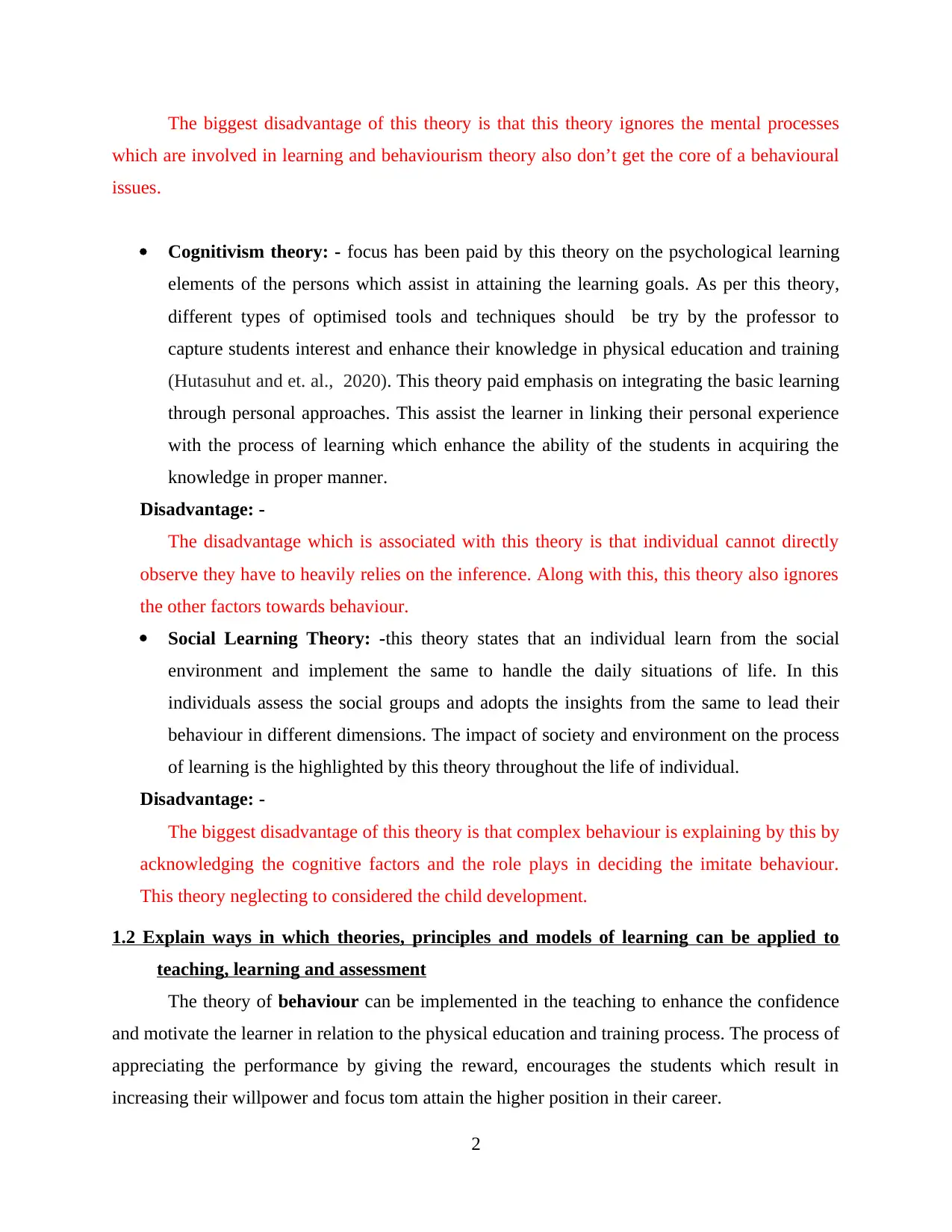
The biggest disadvantage of this theory is that this theory ignores the mental processes
which are involved in learning and behaviourism theory also don’t get the core of a behavioural
issues.
Cognitivism theory: - focus has been paid by this theory on the psychological learning
elements of the persons which assist in attaining the learning goals. As per this theory,
different types of optimised tools and techniques should be try by the professor to
capture students interest and enhance their knowledge in physical education and training
(Hutasuhut and et. al., 2020). This theory paid emphasis on integrating the basic learning
through personal approaches. This assist the learner in linking their personal experience
with the process of learning which enhance the ability of the students in acquiring the
knowledge in proper manner.
Disadvantage: -
The disadvantage which is associated with this theory is that individual cannot directly
observe they have to heavily relies on the inference. Along with this, this theory also ignores
the other factors towards behaviour.
Social Learning Theory: -this theory states that an individual learn from the social
environment and implement the same to handle the daily situations of life. In this
individuals assess the social groups and adopts the insights from the same to lead their
behaviour in different dimensions. The impact of society and environment on the process
of learning is the highlighted by this theory throughout the life of individual.
Disadvantage: -
The biggest disadvantage of this theory is that complex behaviour is explaining by this by
acknowledging the cognitive factors and the role plays in deciding the imitate behaviour.
This theory neglecting to considered the child development.
1.2 Explain ways in which theories, principles and models of learning can be applied to
teaching, learning and assessment
The theory of behaviour can be implemented in the teaching to enhance the confidence
and motivate the learner in relation to the physical education and training process. The process of
appreciating the performance by giving the reward, encourages the students which result in
increasing their willpower and focus tom attain the higher position in their career.
2
which are involved in learning and behaviourism theory also don’t get the core of a behavioural
issues.
Cognitivism theory: - focus has been paid by this theory on the psychological learning
elements of the persons which assist in attaining the learning goals. As per this theory,
different types of optimised tools and techniques should be try by the professor to
capture students interest and enhance their knowledge in physical education and training
(Hutasuhut and et. al., 2020). This theory paid emphasis on integrating the basic learning
through personal approaches. This assist the learner in linking their personal experience
with the process of learning which enhance the ability of the students in acquiring the
knowledge in proper manner.
Disadvantage: -
The disadvantage which is associated with this theory is that individual cannot directly
observe they have to heavily relies on the inference. Along with this, this theory also ignores
the other factors towards behaviour.
Social Learning Theory: -this theory states that an individual learn from the social
environment and implement the same to handle the daily situations of life. In this
individuals assess the social groups and adopts the insights from the same to lead their
behaviour in different dimensions. The impact of society and environment on the process
of learning is the highlighted by this theory throughout the life of individual.
Disadvantage: -
The biggest disadvantage of this theory is that complex behaviour is explaining by this by
acknowledging the cognitive factors and the role plays in deciding the imitate behaviour.
This theory neglecting to considered the child development.
1.2 Explain ways in which theories, principles and models of learning can be applied to
teaching, learning and assessment
The theory of behaviour can be implemented in the teaching to enhance the confidence
and motivate the learner in relation to the physical education and training process. The process of
appreciating the performance by giving the reward, encourages the students which result in
increasing their willpower and focus tom attain the higher position in their career.
2
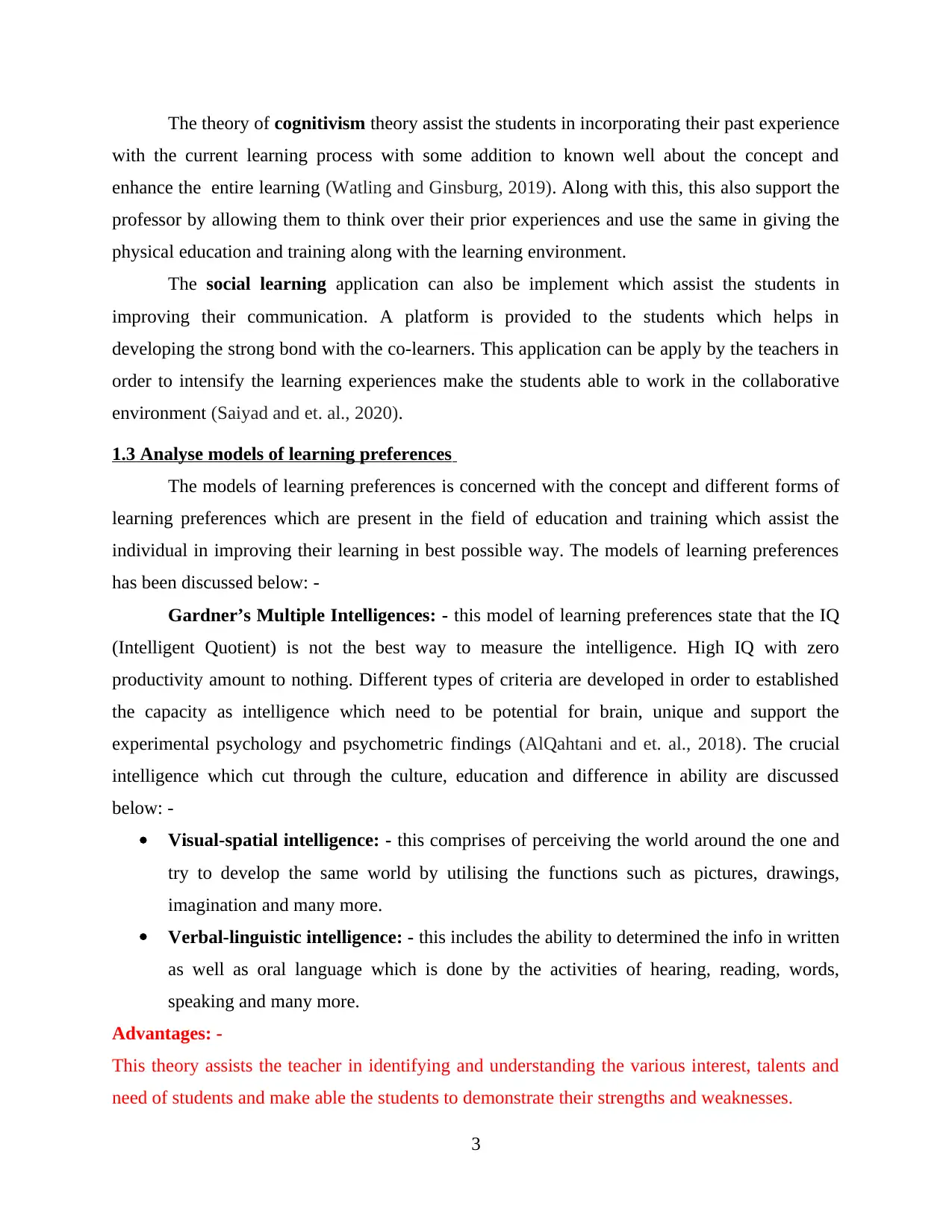
The theory of cognitivism theory assist the students in incorporating their past experience
with the current learning process with some addition to known well about the concept and
enhance the entire learning (Watling and Ginsburg, 2019). Along with this, this also support the
professor by allowing them to think over their prior experiences and use the same in giving the
physical education and training along with the learning environment.
The social learning application can also be implement which assist the students in
improving their communication. A platform is provided to the students which helps in
developing the strong bond with the co-learners. This application can be apply by the teachers in
order to intensify the learning experiences make the students able to work in the collaborative
environment (Saiyad and et. al., 2020).
1.3 Analyse models of learning preferences
The models of learning preferences is concerned with the concept and different forms of
learning preferences which are present in the field of education and training which assist the
individual in improving their learning in best possible way. The models of learning preferences
has been discussed below: -
Gardner’s Multiple Intelligences: - this model of learning preferences state that the IQ
(Intelligent Quotient) is not the best way to measure the intelligence. High IQ with zero
productivity amount to nothing. Different types of criteria are developed in order to established
the capacity as intelligence which need to be potential for brain, unique and support the
experimental psychology and psychometric findings (AlQahtani and et. al., 2018). The crucial
intelligence which cut through the culture, education and difference in ability are discussed
below: -
Visual-spatial intelligence: - this comprises of perceiving the world around the one and
try to develop the same world by utilising the functions such as pictures, drawings,
imagination and many more.
Verbal-linguistic intelligence: - this includes the ability to determined the info in written
as well as oral language which is done by the activities of hearing, reading, words,
speaking and many more.
Advantages: -
This theory assists the teacher in identifying and understanding the various interest, talents and
need of students and make able the students to demonstrate their strengths and weaknesses.
3
with the current learning process with some addition to known well about the concept and
enhance the entire learning (Watling and Ginsburg, 2019). Along with this, this also support the
professor by allowing them to think over their prior experiences and use the same in giving the
physical education and training along with the learning environment.
The social learning application can also be implement which assist the students in
improving their communication. A platform is provided to the students which helps in
developing the strong bond with the co-learners. This application can be apply by the teachers in
order to intensify the learning experiences make the students able to work in the collaborative
environment (Saiyad and et. al., 2020).
1.3 Analyse models of learning preferences
The models of learning preferences is concerned with the concept and different forms of
learning preferences which are present in the field of education and training which assist the
individual in improving their learning in best possible way. The models of learning preferences
has been discussed below: -
Gardner’s Multiple Intelligences: - this model of learning preferences state that the IQ
(Intelligent Quotient) is not the best way to measure the intelligence. High IQ with zero
productivity amount to nothing. Different types of criteria are developed in order to established
the capacity as intelligence which need to be potential for brain, unique and support the
experimental psychology and psychometric findings (AlQahtani and et. al., 2018). The crucial
intelligence which cut through the culture, education and difference in ability are discussed
below: -
Visual-spatial intelligence: - this comprises of perceiving the world around the one and
try to develop the same world by utilising the functions such as pictures, drawings,
imagination and many more.
Verbal-linguistic intelligence: - this includes the ability to determined the info in written
as well as oral language which is done by the activities of hearing, reading, words,
speaking and many more.
Advantages: -
This theory assists the teacher in identifying and understanding the various interest, talents and
need of students and make able the students to demonstrate their strengths and weaknesses.
3
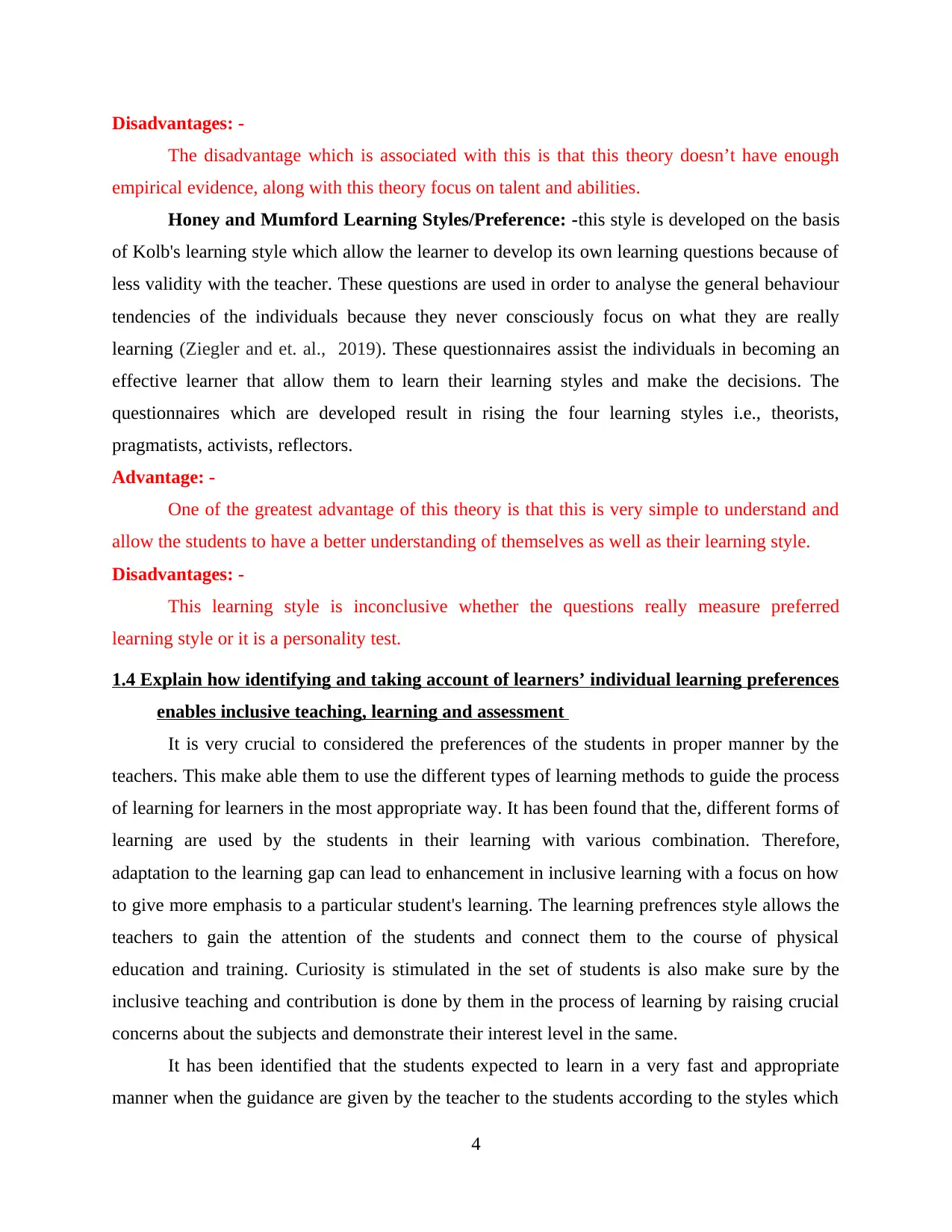
Disadvantages: -
The disadvantage which is associated with this is that this theory doesn’t have enough
empirical evidence, along with this theory focus on talent and abilities.
Honey and Mumford Learning Styles/Preference: -this style is developed on the basis
of Kolb's learning style which allow the learner to develop its own learning questions because of
less validity with the teacher. These questions are used in order to analyse the general behaviour
tendencies of the individuals because they never consciously focus on what they are really
learning (Ziegler and et. al., 2019). These questionnaires assist the individuals in becoming an
effective learner that allow them to learn their learning styles and make the decisions. The
questionnaires which are developed result in rising the four learning styles i.e., theorists,
pragmatists, activists, reflectors.
Advantage: -
One of the greatest advantage of this theory is that this is very simple to understand and
allow the students to have a better understanding of themselves as well as their learning style.
Disadvantages: -
This learning style is inconclusive whether the questions really measure preferred
learning style or it is a personality test.
1.4 Explain how identifying and taking account of learners’ individual learning preferences
enables inclusive teaching, learning and assessment
It is very crucial to considered the preferences of the students in proper manner by the
teachers. This make able them to use the different types of learning methods to guide the process
of learning for learners in the most appropriate way. It has been found that the, different forms of
learning are used by the students in their learning with various combination. Therefore,
adaptation to the learning gap can lead to enhancement in inclusive learning with a focus on how
to give more emphasis to a particular student's learning. The learning prefrences style allows the
teachers to gain the attention of the students and connect them to the course of physical
education and training. Curiosity is stimulated in the set of students is also make sure by the
inclusive teaching and contribution is done by them in the process of learning by raising crucial
concerns about the subjects and demonstrate their interest level in the same.
It has been identified that the students expected to learn in a very fast and appropriate
manner when the guidance are given by the teacher to the students according to the styles which
4
The disadvantage which is associated with this is that this theory doesn’t have enough
empirical evidence, along with this theory focus on talent and abilities.
Honey and Mumford Learning Styles/Preference: -this style is developed on the basis
of Kolb's learning style which allow the learner to develop its own learning questions because of
less validity with the teacher. These questions are used in order to analyse the general behaviour
tendencies of the individuals because they never consciously focus on what they are really
learning (Ziegler and et. al., 2019). These questionnaires assist the individuals in becoming an
effective learner that allow them to learn their learning styles and make the decisions. The
questionnaires which are developed result in rising the four learning styles i.e., theorists,
pragmatists, activists, reflectors.
Advantage: -
One of the greatest advantage of this theory is that this is very simple to understand and
allow the students to have a better understanding of themselves as well as their learning style.
Disadvantages: -
This learning style is inconclusive whether the questions really measure preferred
learning style or it is a personality test.
1.4 Explain how identifying and taking account of learners’ individual learning preferences
enables inclusive teaching, learning and assessment
It is very crucial to considered the preferences of the students in proper manner by the
teachers. This make able them to use the different types of learning methods to guide the process
of learning for learners in the most appropriate way. It has been found that the, different forms of
learning are used by the students in their learning with various combination. Therefore,
adaptation to the learning gap can lead to enhancement in inclusive learning with a focus on how
to give more emphasis to a particular student's learning. The learning prefrences style allows the
teachers to gain the attention of the students and connect them to the course of physical
education and training. Curiosity is stimulated in the set of students is also make sure by the
inclusive teaching and contribution is done by them in the process of learning by raising crucial
concerns about the subjects and demonstrate their interest level in the same.
It has been identified that the students expected to learn in a very fast and appropriate
manner when the guidance are given by the teacher to the students according to the styles which
4
Paraphrase This Document
Need a fresh take? Get an instant paraphrase of this document with our AI Paraphraser
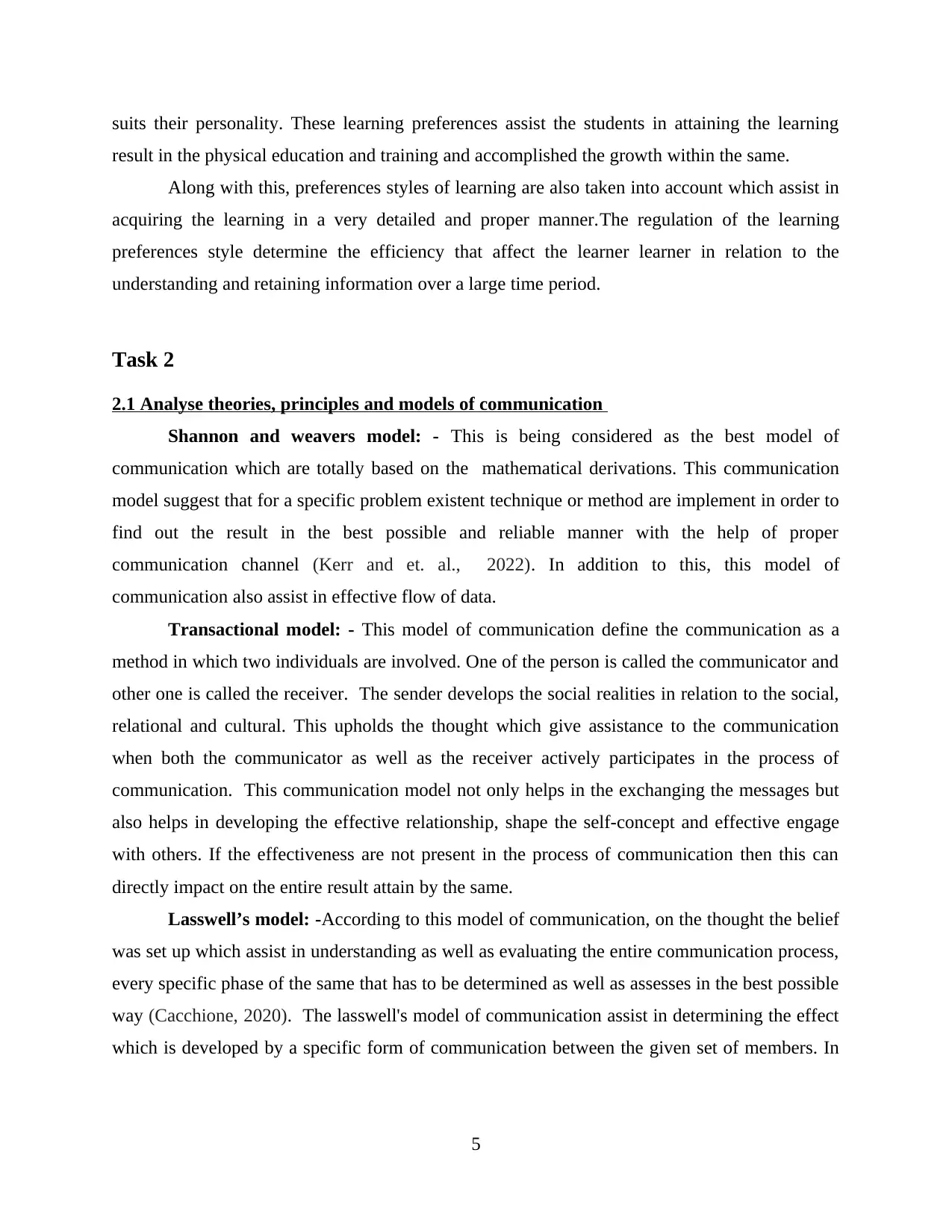
suits their personality. These learning preferences assist the students in attaining the learning
result in the physical education and training and accomplished the growth within the same.
Along with this, preferences styles of learning are also taken into account which assist in
acquiring the learning in a very detailed and proper manner.The regulation of the learning
preferences style determine the efficiency that affect the learner learner in relation to the
understanding and retaining information over a large time period.
Task 2
2.1 Analyse theories, principles and models of communication
Shannon and weavers model: - This is being considered as the best model of
communication which are totally based on the mathematical derivations. This communication
model suggest that for a specific problem existent technique or method are implement in order to
find out the result in the best possible and reliable manner with the help of proper
communication channel (Kerr and et. al., 2022). In addition to this, this model of
communication also assist in effective flow of data.
Transactional model: - This model of communication define the communication as a
method in which two individuals are involved. One of the person is called the communicator and
other one is called the receiver. The sender develops the social realities in relation to the social,
relational and cultural. This upholds the thought which give assistance to the communication
when both the communicator as well as the receiver actively participates in the process of
communication. This communication model not only helps in the exchanging the messages but
also helps in developing the effective relationship, shape the self-concept and effective engage
with others. If the effectiveness are not present in the process of communication then this can
directly impact on the entire result attain by the same.
Lasswell’s model: -According to this model of communication, on the thought the belief
was set up which assist in understanding as well as evaluating the entire communication process,
every specific phase of the same that has to be determined as well as assesses in the best possible
way (Cacchione, 2020). The lasswell's model of communication assist in determining the effect
which is developed by a specific form of communication between the given set of members. In
5
result in the physical education and training and accomplished the growth within the same.
Along with this, preferences styles of learning are also taken into account which assist in
acquiring the learning in a very detailed and proper manner.The regulation of the learning
preferences style determine the efficiency that affect the learner learner in relation to the
understanding and retaining information over a large time period.
Task 2
2.1 Analyse theories, principles and models of communication
Shannon and weavers model: - This is being considered as the best model of
communication which are totally based on the mathematical derivations. This communication
model suggest that for a specific problem existent technique or method are implement in order to
find out the result in the best possible and reliable manner with the help of proper
communication channel (Kerr and et. al., 2022). In addition to this, this model of
communication also assist in effective flow of data.
Transactional model: - This model of communication define the communication as a
method in which two individuals are involved. One of the person is called the communicator and
other one is called the receiver. The sender develops the social realities in relation to the social,
relational and cultural. This upholds the thought which give assistance to the communication
when both the communicator as well as the receiver actively participates in the process of
communication. This communication model not only helps in the exchanging the messages but
also helps in developing the effective relationship, shape the self-concept and effective engage
with others. If the effectiveness are not present in the process of communication then this can
directly impact on the entire result attain by the same.
Lasswell’s model: -According to this model of communication, on the thought the belief
was set up which assist in understanding as well as evaluating the entire communication process,
every specific phase of the same that has to be determined as well as assesses in the best possible
way (Cacchione, 2020). The lasswell's model of communication assist in determining the effect
which is developed by a specific form of communication between the given set of members. In
5
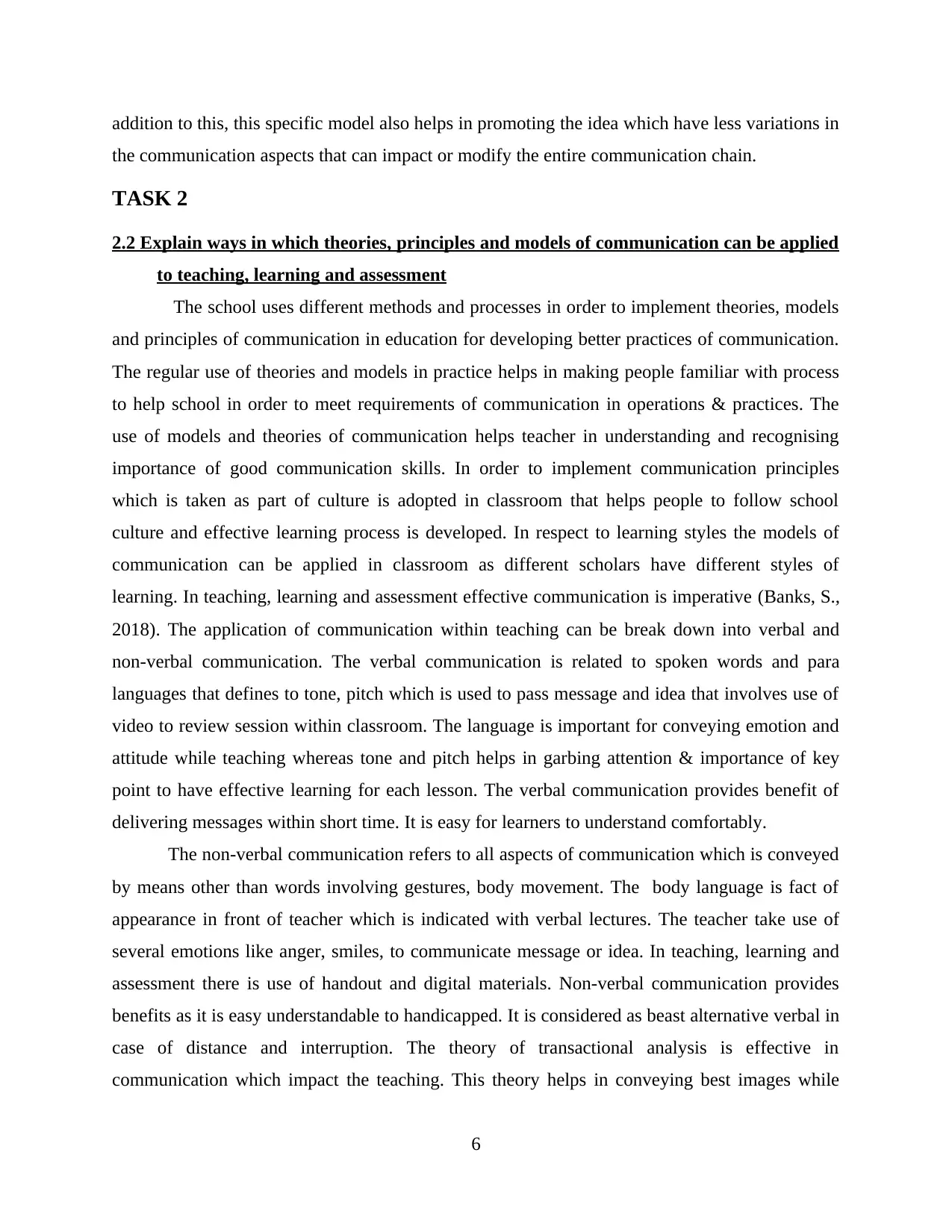
addition to this, this specific model also helps in promoting the idea which have less variations in
the communication aspects that can impact or modify the entire communication chain.
TASK 2
2.2 Explain ways in which theories, principles and models of communication can be applied
to teaching, learning and assessment
The school uses different methods and processes in order to implement theories, models
and principles of communication in education for developing better practices of communication.
The regular use of theories and models in practice helps in making people familiar with process
to help school in order to meet requirements of communication in operations & practices. The
use of models and theories of communication helps teacher in understanding and recognising
importance of good communication skills. In order to implement communication principles
which is taken as part of culture is adopted in classroom that helps people to follow school
culture and effective learning process is developed. In respect to learning styles the models of
communication can be applied in classroom as different scholars have different styles of
learning. In teaching, learning and assessment effective communication is imperative (Banks, S.,
2018). The application of communication within teaching can be break down into verbal and
non-verbal communication. The verbal communication is related to spoken words and para
languages that defines to tone, pitch which is used to pass message and idea that involves use of
video to review session within classroom. The language is important for conveying emotion and
attitude while teaching whereas tone and pitch helps in garbing attention & importance of key
point to have effective learning for each lesson. The verbal communication provides benefit of
delivering messages within short time. It is easy for learners to understand comfortably.
The non-verbal communication refers to all aspects of communication which is conveyed
by means other than words involving gestures, body movement. The body language is fact of
appearance in front of teacher which is indicated with verbal lectures. The teacher take use of
several emotions like anger, smiles, to communicate message or idea. In teaching, learning and
assessment there is use of handout and digital materials. Non-verbal communication provides
benefits as it is easy understandable to handicapped. It is considered as beast alternative verbal in
case of distance and interruption. The theory of transactional analysis is effective in
communication which impact the teaching. This theory helps in conveying best images while
6
the communication aspects that can impact or modify the entire communication chain.
TASK 2
2.2 Explain ways in which theories, principles and models of communication can be applied
to teaching, learning and assessment
The school uses different methods and processes in order to implement theories, models
and principles of communication in education for developing better practices of communication.
The regular use of theories and models in practice helps in making people familiar with process
to help school in order to meet requirements of communication in operations & practices. The
use of models and theories of communication helps teacher in understanding and recognising
importance of good communication skills. In order to implement communication principles
which is taken as part of culture is adopted in classroom that helps people to follow school
culture and effective learning process is developed. In respect to learning styles the models of
communication can be applied in classroom as different scholars have different styles of
learning. In teaching, learning and assessment effective communication is imperative (Banks, S.,
2018). The application of communication within teaching can be break down into verbal and
non-verbal communication. The verbal communication is related to spoken words and para
languages that defines to tone, pitch which is used to pass message and idea that involves use of
video to review session within classroom. The language is important for conveying emotion and
attitude while teaching whereas tone and pitch helps in garbing attention & importance of key
point to have effective learning for each lesson. The verbal communication provides benefit of
delivering messages within short time. It is easy for learners to understand comfortably.
The non-verbal communication refers to all aspects of communication which is conveyed
by means other than words involving gestures, body movement. The body language is fact of
appearance in front of teacher which is indicated with verbal lectures. The teacher take use of
several emotions like anger, smiles, to communicate message or idea. In teaching, learning and
assessment there is use of handout and digital materials. Non-verbal communication provides
benefits as it is easy understandable to handicapped. It is considered as beast alternative verbal in
case of distance and interruption. The theory of transactional analysis is effective in
communication which impact the teaching. This theory helps in conveying best images while
6
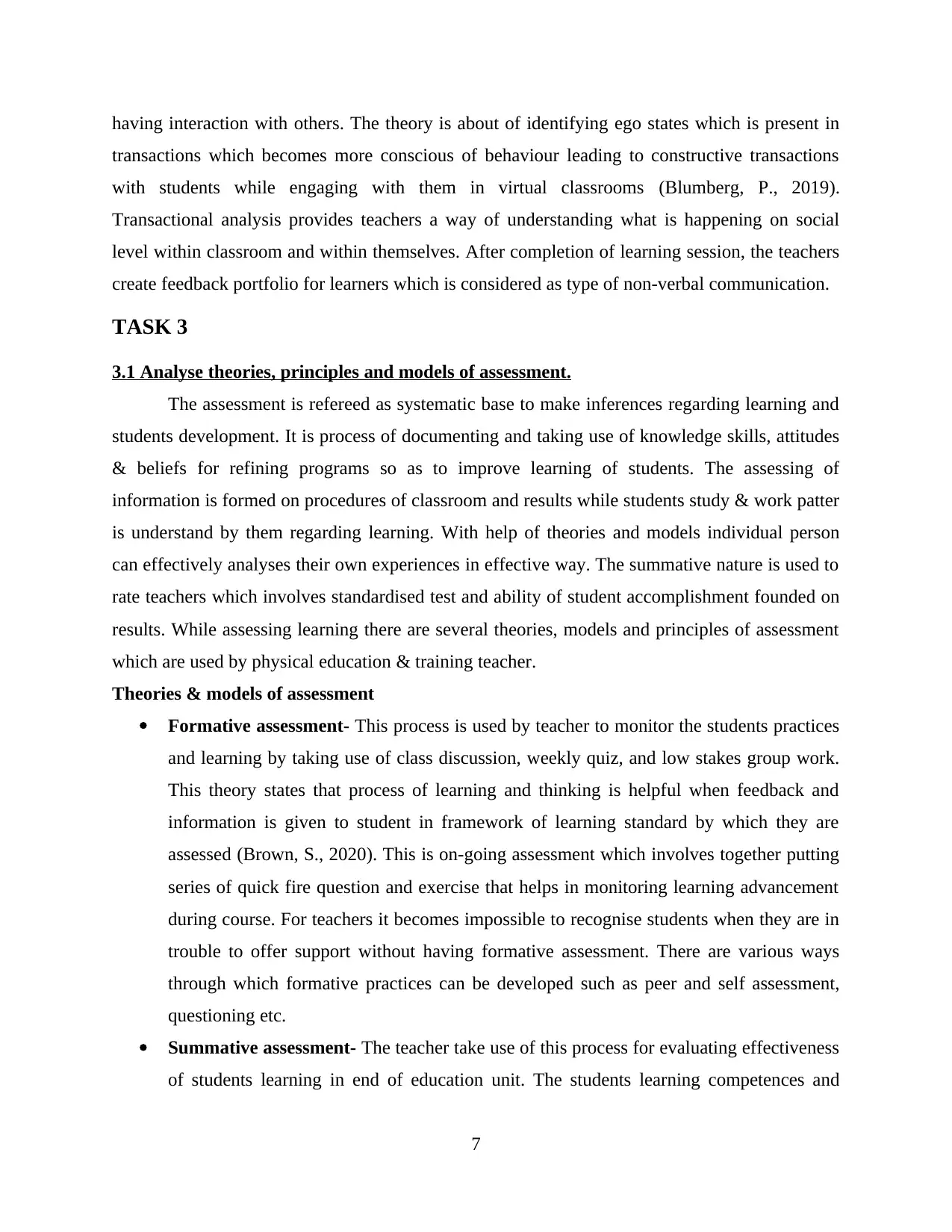
having interaction with others. The theory is about of identifying ego states which is present in
transactions which becomes more conscious of behaviour leading to constructive transactions
with students while engaging with them in virtual classrooms (Blumberg, P., 2019).
Transactional analysis provides teachers a way of understanding what is happening on social
level within classroom and within themselves. After completion of learning session, the teachers
create feedback portfolio for learners which is considered as type of non-verbal communication.
TASK 3
3.1 Analyse theories, principles and models of assessment.
The assessment is refereed as systematic base to make inferences regarding learning and
students development. It is process of documenting and taking use of knowledge skills, attitudes
& beliefs for refining programs so as to improve learning of students. The assessing of
information is formed on procedures of classroom and results while students study & work patter
is understand by them regarding learning. With help of theories and models individual person
can effectively analyses their own experiences in effective way. The summative nature is used to
rate teachers which involves standardised test and ability of student accomplishment founded on
results. While assessing learning there are several theories, models and principles of assessment
which are used by physical education & training teacher.
Theories & models of assessment
Formative assessment- This process is used by teacher to monitor the students practices
and learning by taking use of class discussion, weekly quiz, and low stakes group work.
This theory states that process of learning and thinking is helpful when feedback and
information is given to student in framework of learning standard by which they are
assessed (Brown, S., 2020). This is on-going assessment which involves together putting
series of quick fire question and exercise that helps in monitoring learning advancement
during course. For teachers it becomes impossible to recognise students when they are in
trouble to offer support without having formative assessment. There are various ways
through which formative practices can be developed such as peer and self assessment,
questioning etc.
Summative assessment- The teacher take use of this process for evaluating effectiveness
of students learning in end of education unit. The students learning competences and
7
transactions which becomes more conscious of behaviour leading to constructive transactions
with students while engaging with them in virtual classrooms (Blumberg, P., 2019).
Transactional analysis provides teachers a way of understanding what is happening on social
level within classroom and within themselves. After completion of learning session, the teachers
create feedback portfolio for learners which is considered as type of non-verbal communication.
TASK 3
3.1 Analyse theories, principles and models of assessment.
The assessment is refereed as systematic base to make inferences regarding learning and
students development. It is process of documenting and taking use of knowledge skills, attitudes
& beliefs for refining programs so as to improve learning of students. The assessing of
information is formed on procedures of classroom and results while students study & work patter
is understand by them regarding learning. With help of theories and models individual person
can effectively analyses their own experiences in effective way. The summative nature is used to
rate teachers which involves standardised test and ability of student accomplishment founded on
results. While assessing learning there are several theories, models and principles of assessment
which are used by physical education & training teacher.
Theories & models of assessment
Formative assessment- This process is used by teacher to monitor the students practices
and learning by taking use of class discussion, weekly quiz, and low stakes group work.
This theory states that process of learning and thinking is helpful when feedback and
information is given to student in framework of learning standard by which they are
assessed (Brown, S., 2020). This is on-going assessment which involves together putting
series of quick fire question and exercise that helps in monitoring learning advancement
during course. For teachers it becomes impossible to recognise students when they are in
trouble to offer support without having formative assessment. There are various ways
through which formative practices can be developed such as peer and self assessment,
questioning etc.
Summative assessment- The teacher take use of this process for evaluating effectiveness
of students learning in end of education unit. The students learning competences and
7
Secure Best Marks with AI Grader
Need help grading? Try our AI Grader for instant feedback on your assignments.
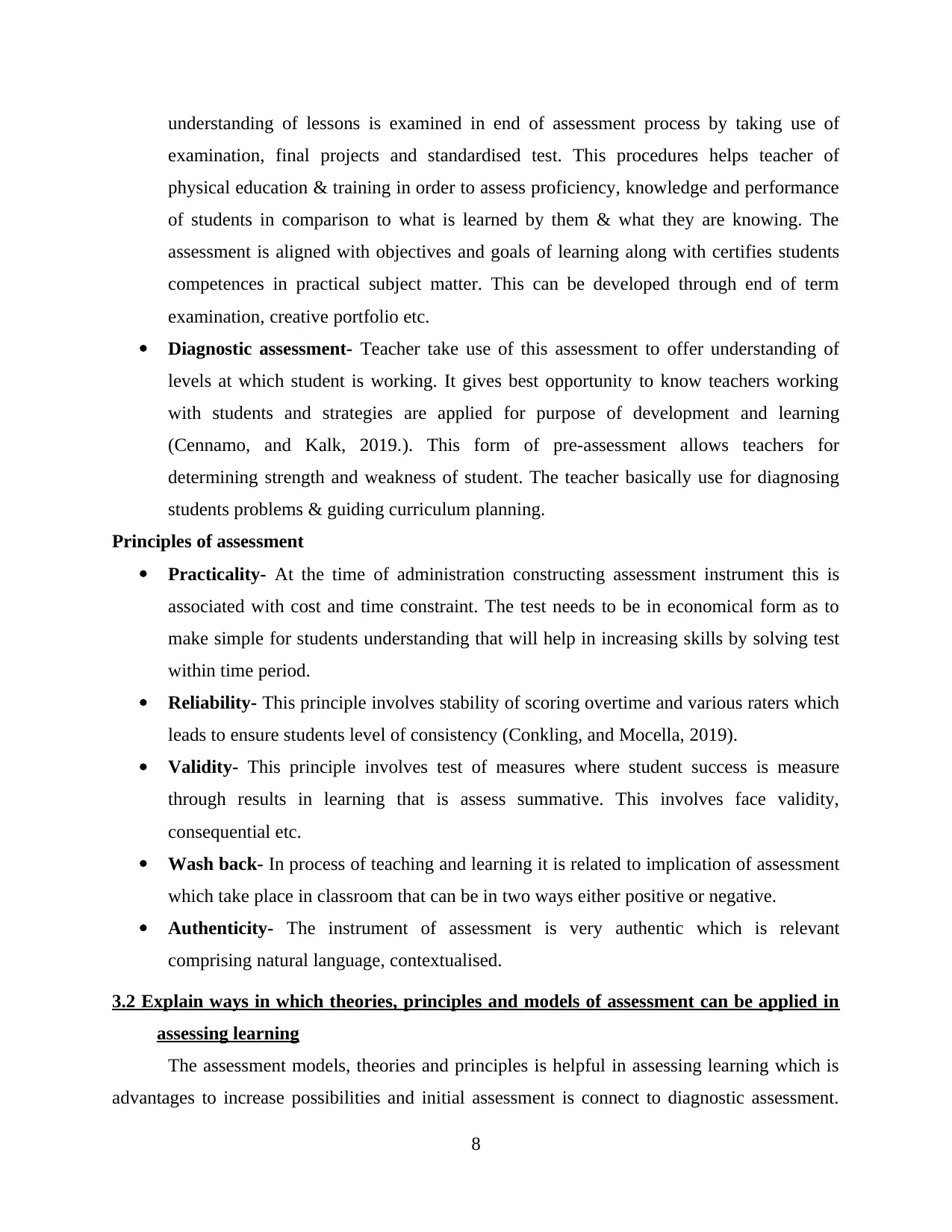
understanding of lessons is examined in end of assessment process by taking use of
examination, final projects and standardised test. This procedures helps teacher of
physical education & training in order to assess proficiency, knowledge and performance
of students in comparison to what is learned by them & what they are knowing. The
assessment is aligned with objectives and goals of learning along with certifies students
competences in practical subject matter. This can be developed through end of term
examination, creative portfolio etc.
Diagnostic assessment- Teacher take use of this assessment to offer understanding of
levels at which student is working. It gives best opportunity to know teachers working
with students and strategies are applied for purpose of development and learning
(Cennamo, and Kalk, 2019.). This form of pre-assessment allows teachers for
determining strength and weakness of student. The teacher basically use for diagnosing
students problems & guiding curriculum planning.
Principles of assessment
Practicality- At the time of administration constructing assessment instrument this is
associated with cost and time constraint. The test needs to be in economical form as to
make simple for students understanding that will help in increasing skills by solving test
within time period.
Reliability- This principle involves stability of scoring overtime and various raters which
leads to ensure students level of consistency (Conkling, and Mocella, 2019).
Validity- This principle involves test of measures where student success is measure
through results in learning that is assess summative. This involves face validity,
consequential etc.
Wash back- In process of teaching and learning it is related to implication of assessment
which take place in classroom that can be in two ways either positive or negative.
Authenticity- The instrument of assessment is very authentic which is relevant
comprising natural language, contextualised.
3.2 Explain ways in which theories, principles and models of assessment can be applied in
assessing learning
The assessment models, theories and principles is helpful in assessing learning which is
advantages to increase possibilities and initial assessment is connect to diagnostic assessment.
8
examination, final projects and standardised test. This procedures helps teacher of
physical education & training in order to assess proficiency, knowledge and performance
of students in comparison to what is learned by them & what they are knowing. The
assessment is aligned with objectives and goals of learning along with certifies students
competences in practical subject matter. This can be developed through end of term
examination, creative portfolio etc.
Diagnostic assessment- Teacher take use of this assessment to offer understanding of
levels at which student is working. It gives best opportunity to know teachers working
with students and strategies are applied for purpose of development and learning
(Cennamo, and Kalk, 2019.). This form of pre-assessment allows teachers for
determining strength and weakness of student. The teacher basically use for diagnosing
students problems & guiding curriculum planning.
Principles of assessment
Practicality- At the time of administration constructing assessment instrument this is
associated with cost and time constraint. The test needs to be in economical form as to
make simple for students understanding that will help in increasing skills by solving test
within time period.
Reliability- This principle involves stability of scoring overtime and various raters which
leads to ensure students level of consistency (Conkling, and Mocella, 2019).
Validity- This principle involves test of measures where student success is measure
through results in learning that is assess summative. This involves face validity,
consequential etc.
Wash back- In process of teaching and learning it is related to implication of assessment
which take place in classroom that can be in two ways either positive or negative.
Authenticity- The instrument of assessment is very authentic which is relevant
comprising natural language, contextualised.
3.2 Explain ways in which theories, principles and models of assessment can be applied in
assessing learning
The assessment models, theories and principles is helpful in assessing learning which is
advantages to increase possibilities and initial assessment is connect to diagnostic assessment.
8
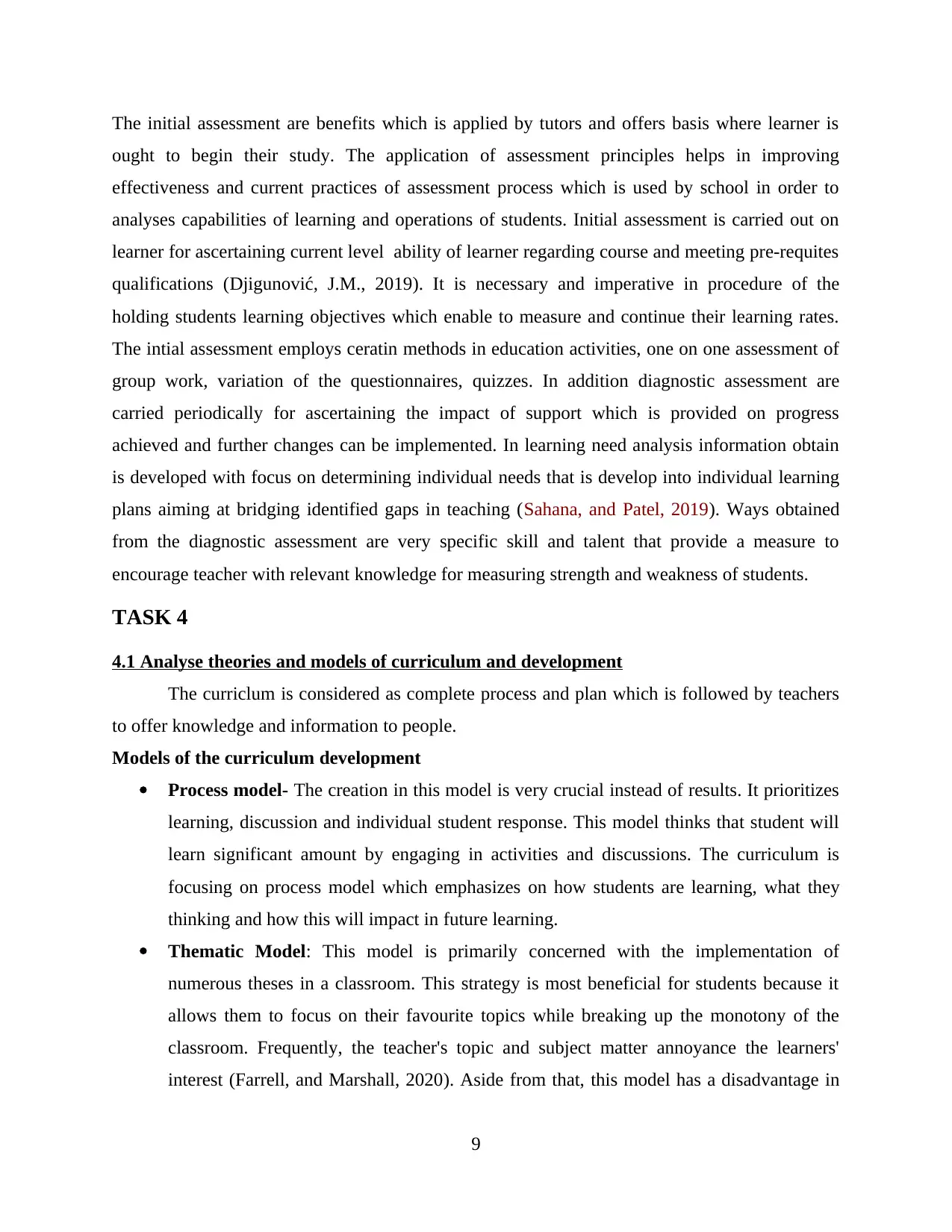
The initial assessment are benefits which is applied by tutors and offers basis where learner is
ought to begin their study. The application of assessment principles helps in improving
effectiveness and current practices of assessment process which is used by school in order to
analyses capabilities of learning and operations of students. Initial assessment is carried out on
learner for ascertaining current level ability of learner regarding course and meeting pre-requites
qualifications (Djigunović, J.M., 2019). It is necessary and imperative in procedure of the
holding students learning objectives which enable to measure and continue their learning rates.
The intial assessment employs ceratin methods in education activities, one on one assessment of
group work, variation of the questionnaires, quizzes. In addition diagnostic assessment are
carried periodically for ascertaining the impact of support which is provided on progress
achieved and further changes can be implemented. In learning need analysis information obtain
is developed with focus on determining individual needs that is develop into individual learning
plans aiming at bridging identified gaps in teaching (Sahana, and Patel, 2019). Ways obtained
from the diagnostic assessment are very specific skill and talent that provide a measure to
encourage teacher with relevant knowledge for measuring strength and weakness of students.
TASK 4
4.1 Analyse theories and models of curriculum and development
The curriclum is considered as complete process and plan which is followed by teachers
to offer knowledge and information to people.
Models of the curriculum development
Process model- The creation in this model is very crucial instead of results. It prioritizes
learning, discussion and individual student response. This model thinks that student will
learn significant amount by engaging in activities and discussions. The curriculum is
focusing on process model which emphasizes on how students are learning, what they
thinking and how this will impact in future learning.
Thematic Model: This model is primarily concerned with the implementation of
numerous theses in a classroom. This strategy is most beneficial for students because it
allows them to focus on their favourite topics while breaking up the monotony of the
classroom. Frequently, the teacher's topic and subject matter annoyance the learners'
interest (Farrell, and Marshall, 2020). Aside from that, this model has a disadvantage in
9
ought to begin their study. The application of assessment principles helps in improving
effectiveness and current practices of assessment process which is used by school in order to
analyses capabilities of learning and operations of students. Initial assessment is carried out on
learner for ascertaining current level ability of learner regarding course and meeting pre-requites
qualifications (Djigunović, J.M., 2019). It is necessary and imperative in procedure of the
holding students learning objectives which enable to measure and continue their learning rates.
The intial assessment employs ceratin methods in education activities, one on one assessment of
group work, variation of the questionnaires, quizzes. In addition diagnostic assessment are
carried periodically for ascertaining the impact of support which is provided on progress
achieved and further changes can be implemented. In learning need analysis information obtain
is developed with focus on determining individual needs that is develop into individual learning
plans aiming at bridging identified gaps in teaching (Sahana, and Patel, 2019). Ways obtained
from the diagnostic assessment are very specific skill and talent that provide a measure to
encourage teacher with relevant knowledge for measuring strength and weakness of students.
TASK 4
4.1 Analyse theories and models of curriculum and development
The curriclum is considered as complete process and plan which is followed by teachers
to offer knowledge and information to people.
Models of the curriculum development
Process model- The creation in this model is very crucial instead of results. It prioritizes
learning, discussion and individual student response. This model thinks that student will
learn significant amount by engaging in activities and discussions. The curriculum is
focusing on process model which emphasizes on how students are learning, what they
thinking and how this will impact in future learning.
Thematic Model: This model is primarily concerned with the implementation of
numerous theses in a classroom. This strategy is most beneficial for students because it
allows them to focus on their favourite topics while breaking up the monotony of the
classroom. Frequently, the teacher's topic and subject matter annoyance the learners'
interest (Farrell, and Marshall, 2020). Aside from that, this model has a disadvantage in
9
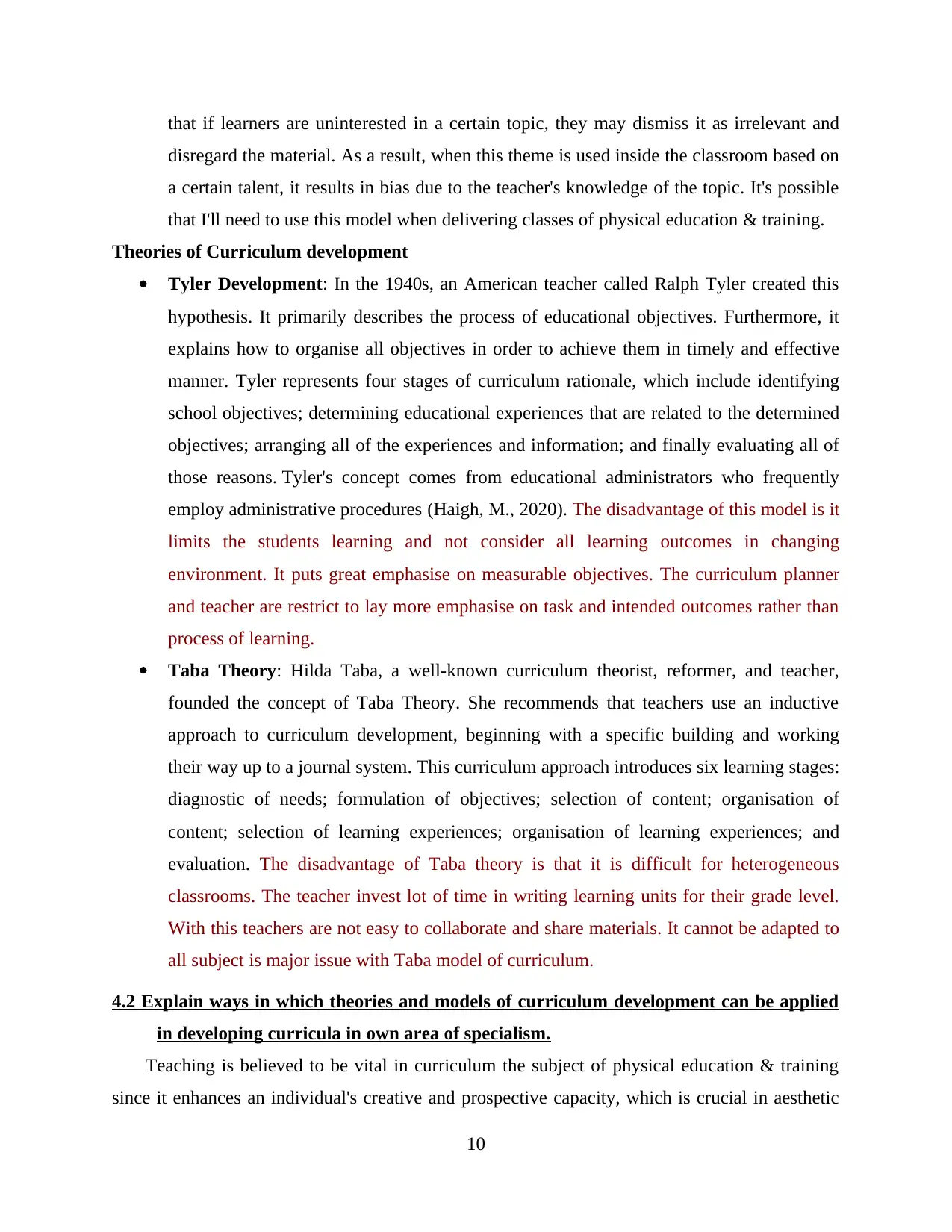
that if learners are uninterested in a certain topic, they may dismiss it as irrelevant and
disregard the material. As a result, when this theme is used inside the classroom based on
a certain talent, it results in bias due to the teacher's knowledge of the topic. It's possible
that I'll need to use this model when delivering classes of physical education & training.
Theories of Curriculum development
Tyler Development: In the 1940s, an American teacher called Ralph Tyler created this
hypothesis. It primarily describes the process of educational objectives. Furthermore, it
explains how to organise all objectives in order to achieve them in timely and effective
manner. Tyler represents four stages of curriculum rationale, which include identifying
school objectives; determining educational experiences that are related to the determined
objectives; arranging all of the experiences and information; and finally evaluating all of
those reasons. Tyler's concept comes from educational administrators who frequently
employ administrative procedures (Haigh, M., 2020). The disadvantage of this model is it
limits the students learning and not consider all learning outcomes in changing
environment. It puts great emphasise on measurable objectives. The curriculum planner
and teacher are restrict to lay more emphasise on task and intended outcomes rather than
process of learning.
Taba Theory: Hilda Taba, a well-known curriculum theorist, reformer, and teacher,
founded the concept of Taba Theory. She recommends that teachers use an inductive
approach to curriculum development, beginning with a specific building and working
their way up to a journal system. This curriculum approach introduces six learning stages:
diagnostic of needs; formulation of objectives; selection of content; organisation of
content; selection of learning experiences; organisation of learning experiences; and
evaluation. The disadvantage of Taba theory is that it is difficult for heterogeneous
classrooms. The teacher invest lot of time in writing learning units for their grade level.
With this teachers are not easy to collaborate and share materials. It cannot be adapted to
all subject is major issue with Taba model of curriculum.
4.2 Explain ways in which theories and models of curriculum development can be applied
in developing curricula in own area of specialism.
Teaching is believed to be vital in curriculum the subject of physical education & training
since it enhances an individual's creative and prospective capacity, which is crucial in aesthetic
10
disregard the material. As a result, when this theme is used inside the classroom based on
a certain talent, it results in bias due to the teacher's knowledge of the topic. It's possible
that I'll need to use this model when delivering classes of physical education & training.
Theories of Curriculum development
Tyler Development: In the 1940s, an American teacher called Ralph Tyler created this
hypothesis. It primarily describes the process of educational objectives. Furthermore, it
explains how to organise all objectives in order to achieve them in timely and effective
manner. Tyler represents four stages of curriculum rationale, which include identifying
school objectives; determining educational experiences that are related to the determined
objectives; arranging all of the experiences and information; and finally evaluating all of
those reasons. Tyler's concept comes from educational administrators who frequently
employ administrative procedures (Haigh, M., 2020). The disadvantage of this model is it
limits the students learning and not consider all learning outcomes in changing
environment. It puts great emphasise on measurable objectives. The curriculum planner
and teacher are restrict to lay more emphasise on task and intended outcomes rather than
process of learning.
Taba Theory: Hilda Taba, a well-known curriculum theorist, reformer, and teacher,
founded the concept of Taba Theory. She recommends that teachers use an inductive
approach to curriculum development, beginning with a specific building and working
their way up to a journal system. This curriculum approach introduces six learning stages:
diagnostic of needs; formulation of objectives; selection of content; organisation of
content; selection of learning experiences; organisation of learning experiences; and
evaluation. The disadvantage of Taba theory is that it is difficult for heterogeneous
classrooms. The teacher invest lot of time in writing learning units for their grade level.
With this teachers are not easy to collaborate and share materials. It cannot be adapted to
all subject is major issue with Taba model of curriculum.
4.2 Explain ways in which theories and models of curriculum development can be applied
in developing curricula in own area of specialism.
Teaching is believed to be vital in curriculum the subject of physical education & training
since it enhances an individual's creative and prospective capacity, which is crucial in aesthetic
10
Paraphrase This Document
Need a fresh take? Get an instant paraphrase of this document with our AI Paraphraser
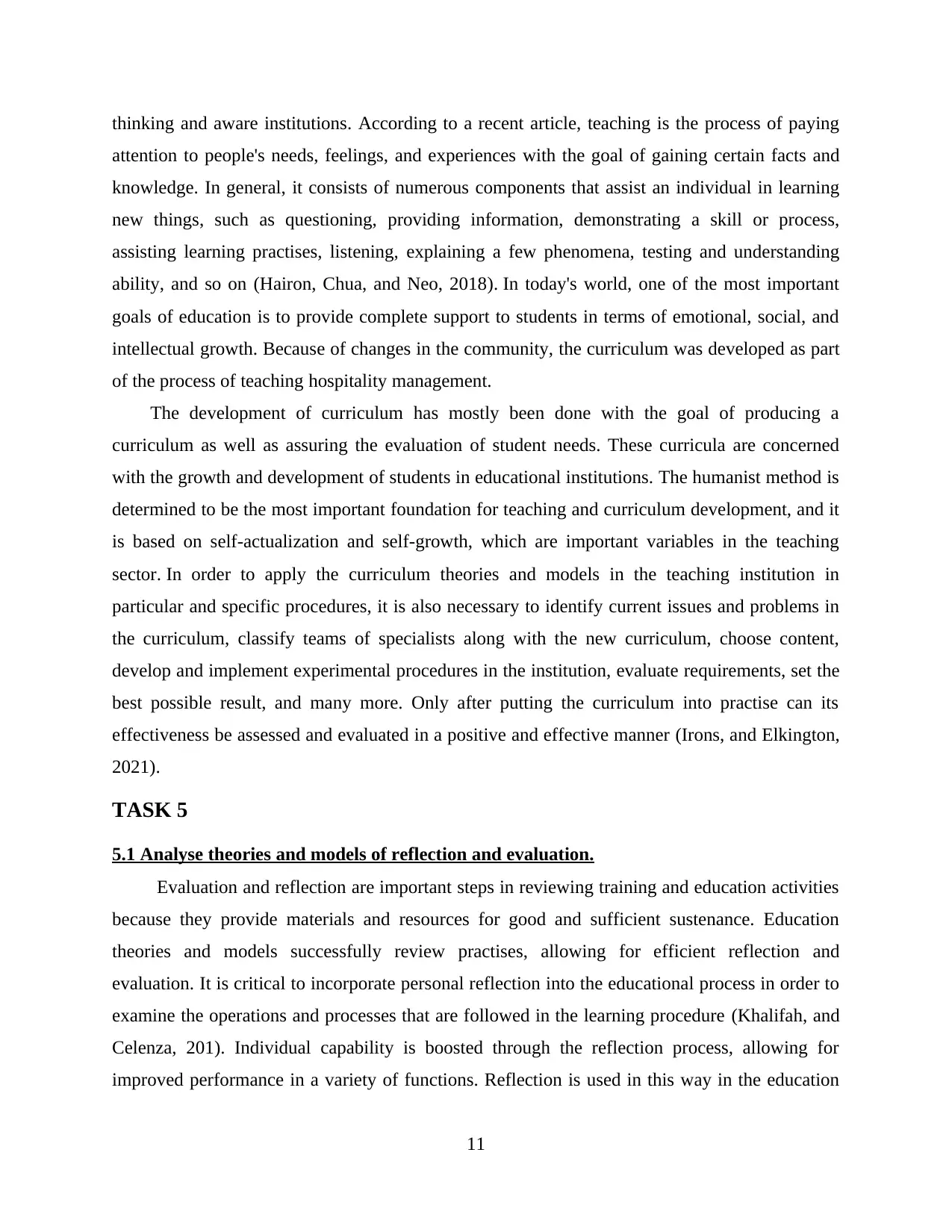
thinking and aware institutions. According to a recent article, teaching is the process of paying
attention to people's needs, feelings, and experiences with the goal of gaining certain facts and
knowledge. In general, it consists of numerous components that assist an individual in learning
new things, such as questioning, providing information, demonstrating a skill or process,
assisting learning practises, listening, explaining a few phenomena, testing and understanding
ability, and so on (Hairon, Chua, and Neo, 2018). In today's world, one of the most important
goals of education is to provide complete support to students in terms of emotional, social, and
intellectual growth. Because of changes in the community, the curriculum was developed as part
of the process of teaching hospitality management.
The development of curriculum has mostly been done with the goal of producing a
curriculum as well as assuring the evaluation of student needs. These curricula are concerned
with the growth and development of students in educational institutions. The humanist method is
determined to be the most important foundation for teaching and curriculum development, and it
is based on self-actualization and self-growth, which are important variables in the teaching
sector. In order to apply the curriculum theories and models in the teaching institution in
particular and specific procedures, it is also necessary to identify current issues and problems in
the curriculum, classify teams of specialists along with the new curriculum, choose content,
develop and implement experimental procedures in the institution, evaluate requirements, set the
best possible result, and many more. Only after putting the curriculum into practise can its
effectiveness be assessed and evaluated in a positive and effective manner (Irons, and Elkington,
2021).
TASK 5
5.1 Analyse theories and models of reflection and evaluation.
Evaluation and reflection are important steps in reviewing training and education activities
because they provide materials and resources for good and sufficient sustenance. Education
theories and models successfully review practises, allowing for efficient reflection and
evaluation. It is critical to incorporate personal reflection into the educational process in order to
examine the operations and processes that are followed in the learning procedure (Khalifah, and
Celenza, 201). Individual capability is boosted through the reflection process, allowing for
improved performance in a variety of functions. Reflection is used in this way in the education
11
attention to people's needs, feelings, and experiences with the goal of gaining certain facts and
knowledge. In general, it consists of numerous components that assist an individual in learning
new things, such as questioning, providing information, demonstrating a skill or process,
assisting learning practises, listening, explaining a few phenomena, testing and understanding
ability, and so on (Hairon, Chua, and Neo, 2018). In today's world, one of the most important
goals of education is to provide complete support to students in terms of emotional, social, and
intellectual growth. Because of changes in the community, the curriculum was developed as part
of the process of teaching hospitality management.
The development of curriculum has mostly been done with the goal of producing a
curriculum as well as assuring the evaluation of student needs. These curricula are concerned
with the growth and development of students in educational institutions. The humanist method is
determined to be the most important foundation for teaching and curriculum development, and it
is based on self-actualization and self-growth, which are important variables in the teaching
sector. In order to apply the curriculum theories and models in the teaching institution in
particular and specific procedures, it is also necessary to identify current issues and problems in
the curriculum, classify teams of specialists along with the new curriculum, choose content,
develop and implement experimental procedures in the institution, evaluate requirements, set the
best possible result, and many more. Only after putting the curriculum into practise can its
effectiveness be assessed and evaluated in a positive and effective manner (Irons, and Elkington,
2021).
TASK 5
5.1 Analyse theories and models of reflection and evaluation.
Evaluation and reflection are important steps in reviewing training and education activities
because they provide materials and resources for good and sufficient sustenance. Education
theories and models successfully review practises, allowing for efficient reflection and
evaluation. It is critical to incorporate personal reflection into the educational process in order to
examine the operations and processes that are followed in the learning procedure (Khalifah, and
Celenza, 201). Individual capability is boosted through the reflection process, allowing for
improved performance in a variety of functions. Reflection is used in this way in the education
11
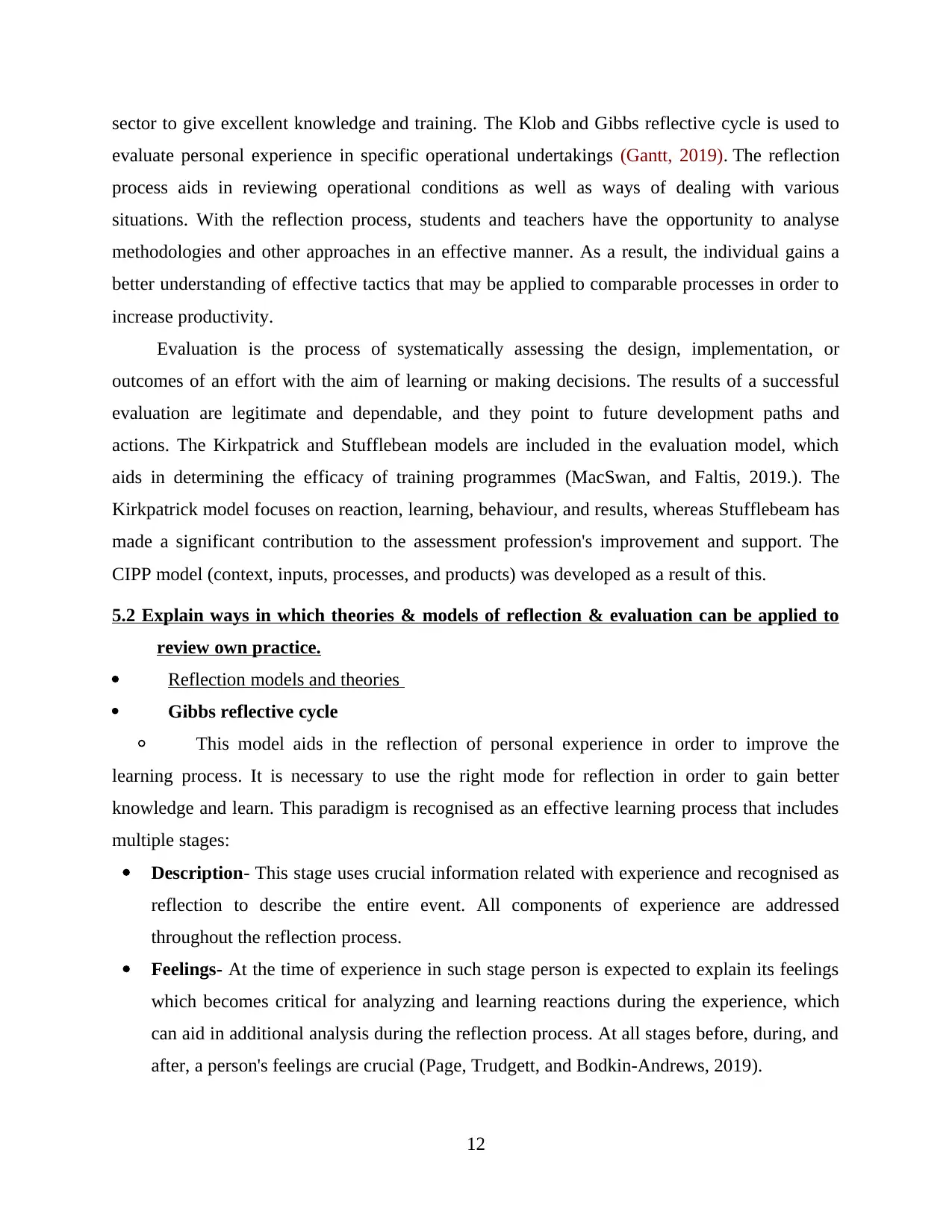
sector to give excellent knowledge and training. The Klob and Gibbs reflective cycle is used to
evaluate personal experience in specific operational undertakings (Gantt, 2019). The reflection
process aids in reviewing operational conditions as well as ways of dealing with various
situations. With the reflection process, students and teachers have the opportunity to analyse
methodologies and other approaches in an effective manner. As a result, the individual gains a
better understanding of effective tactics that may be applied to comparable processes in order to
increase productivity.
Evaluation is the process of systematically assessing the design, implementation, or
outcomes of an effort with the aim of learning or making decisions. The results of a successful
evaluation are legitimate and dependable, and they point to future development paths and
actions. The Kirkpatrick and Stufflebean models are included in the evaluation model, which
aids in determining the efficacy of training programmes (MacSwan, and Faltis, 2019.). The
Kirkpatrick model focuses on reaction, learning, behaviour, and results, whereas Stufflebeam has
made a significant contribution to the assessment profession's improvement and support. The
CIPP model (context, inputs, processes, and products) was developed as a result of this.
5.2 Explain ways in which theories & models of reflection & evaluation can be applied to
review own practice.
Reflection models and theories
Gibbs reflective cycle
◦ This model aids in the reflection of personal experience in order to improve the
learning process. It is necessary to use the right mode for reflection in order to gain better
knowledge and learn. This paradigm is recognised as an effective learning process that includes
multiple stages:
Description- This stage uses crucial information related with experience and recognised as
reflection to describe the entire event. All components of experience are addressed
throughout the reflection process.
Feelings- At the time of experience in such stage person is expected to explain its feelings
which becomes critical for analyzing and learning reactions during the experience, which
can aid in additional analysis during the reflection process. At all stages before, during, and
after, a person's feelings are crucial (Page, Trudgett, and Bodkin-Andrews, 2019).
12
evaluate personal experience in specific operational undertakings (Gantt, 2019). The reflection
process aids in reviewing operational conditions as well as ways of dealing with various
situations. With the reflection process, students and teachers have the opportunity to analyse
methodologies and other approaches in an effective manner. As a result, the individual gains a
better understanding of effective tactics that may be applied to comparable processes in order to
increase productivity.
Evaluation is the process of systematically assessing the design, implementation, or
outcomes of an effort with the aim of learning or making decisions. The results of a successful
evaluation are legitimate and dependable, and they point to future development paths and
actions. The Kirkpatrick and Stufflebean models are included in the evaluation model, which
aids in determining the efficacy of training programmes (MacSwan, and Faltis, 2019.). The
Kirkpatrick model focuses on reaction, learning, behaviour, and results, whereas Stufflebeam has
made a significant contribution to the assessment profession's improvement and support. The
CIPP model (context, inputs, processes, and products) was developed as a result of this.
5.2 Explain ways in which theories & models of reflection & evaluation can be applied to
review own practice.
Reflection models and theories
Gibbs reflective cycle
◦ This model aids in the reflection of personal experience in order to improve the
learning process. It is necessary to use the right mode for reflection in order to gain better
knowledge and learn. This paradigm is recognised as an effective learning process that includes
multiple stages:
Description- This stage uses crucial information related with experience and recognised as
reflection to describe the entire event. All components of experience are addressed
throughout the reflection process.
Feelings- At the time of experience in such stage person is expected to explain its feelings
which becomes critical for analyzing and learning reactions during the experience, which
can aid in additional analysis during the reflection process. At all stages before, during, and
after, a person's feelings are crucial (Page, Trudgett, and Bodkin-Andrews, 2019).
12
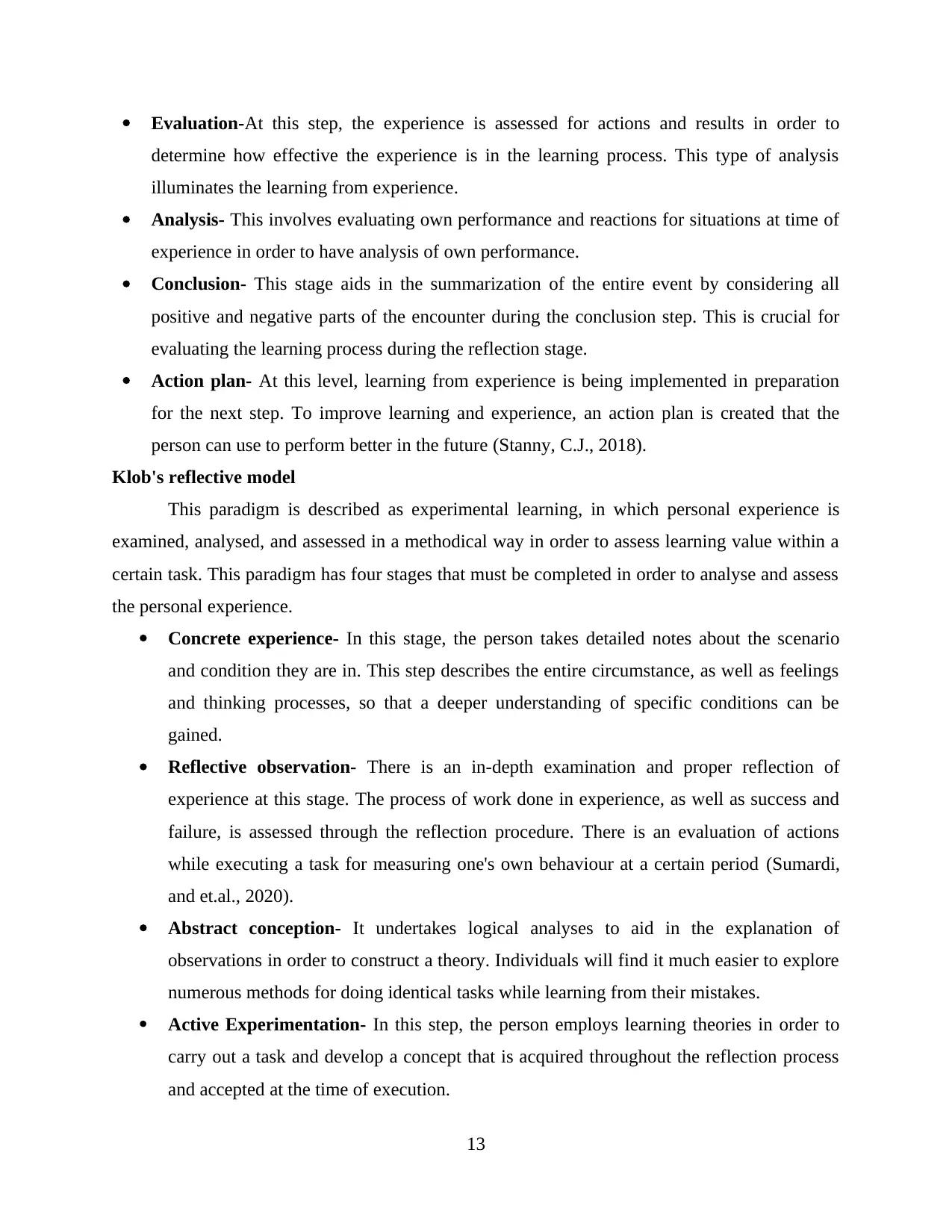
Evaluation-At this step, the experience is assessed for actions and results in order to
determine how effective the experience is in the learning process. This type of analysis
illuminates the learning from experience.
Analysis- This involves evaluating own performance and reactions for situations at time of
experience in order to have analysis of own performance.
Conclusion- This stage aids in the summarization of the entire event by considering all
positive and negative parts of the encounter during the conclusion step. This is crucial for
evaluating the learning process during the reflection stage.
Action plan- At this level, learning from experience is being implemented in preparation
for the next step. To improve learning and experience, an action plan is created that the
person can use to perform better in the future (Stanny, C.J., 2018).
Klob's reflective model
This paradigm is described as experimental learning, in which personal experience is
examined, analysed, and assessed in a methodical way in order to assess learning value within a
certain task. This paradigm has four stages that must be completed in order to analyse and assess
the personal experience.
Concrete experience- In this stage, the person takes detailed notes about the scenario
and condition they are in. This step describes the entire circumstance, as well as feelings
and thinking processes, so that a deeper understanding of specific conditions can be
gained.
Reflective observation- There is an in-depth examination and proper reflection of
experience at this stage. The process of work done in experience, as well as success and
failure, is assessed through the reflection procedure. There is an evaluation of actions
while executing a task for measuring one's own behaviour at a certain period (Sumardi,
and et.al., 2020).
Abstract conception- It undertakes logical analyses to aid in the explanation of
observations in order to construct a theory. Individuals will find it much easier to explore
numerous methods for doing identical tasks while learning from their mistakes.
Active Experimentation- In this step, the person employs learning theories in order to
carry out a task and develop a concept that is acquired throughout the reflection process
and accepted at the time of execution.
13
determine how effective the experience is in the learning process. This type of analysis
illuminates the learning from experience.
Analysis- This involves evaluating own performance and reactions for situations at time of
experience in order to have analysis of own performance.
Conclusion- This stage aids in the summarization of the entire event by considering all
positive and negative parts of the encounter during the conclusion step. This is crucial for
evaluating the learning process during the reflection stage.
Action plan- At this level, learning from experience is being implemented in preparation
for the next step. To improve learning and experience, an action plan is created that the
person can use to perform better in the future (Stanny, C.J., 2018).
Klob's reflective model
This paradigm is described as experimental learning, in which personal experience is
examined, analysed, and assessed in a methodical way in order to assess learning value within a
certain task. This paradigm has four stages that must be completed in order to analyse and assess
the personal experience.
Concrete experience- In this stage, the person takes detailed notes about the scenario
and condition they are in. This step describes the entire circumstance, as well as feelings
and thinking processes, so that a deeper understanding of specific conditions can be
gained.
Reflective observation- There is an in-depth examination and proper reflection of
experience at this stage. The process of work done in experience, as well as success and
failure, is assessed through the reflection procedure. There is an evaluation of actions
while executing a task for measuring one's own behaviour at a certain period (Sumardi,
and et.al., 2020).
Abstract conception- It undertakes logical analyses to aid in the explanation of
observations in order to construct a theory. Individuals will find it much easier to explore
numerous methods for doing identical tasks while learning from their mistakes.
Active Experimentation- In this step, the person employs learning theories in order to
carry out a task and develop a concept that is acquired throughout the reflection process
and accepted at the time of execution.
13
Secure Best Marks with AI Grader
Need help grading? Try our AI Grader for instant feedback on your assignments.
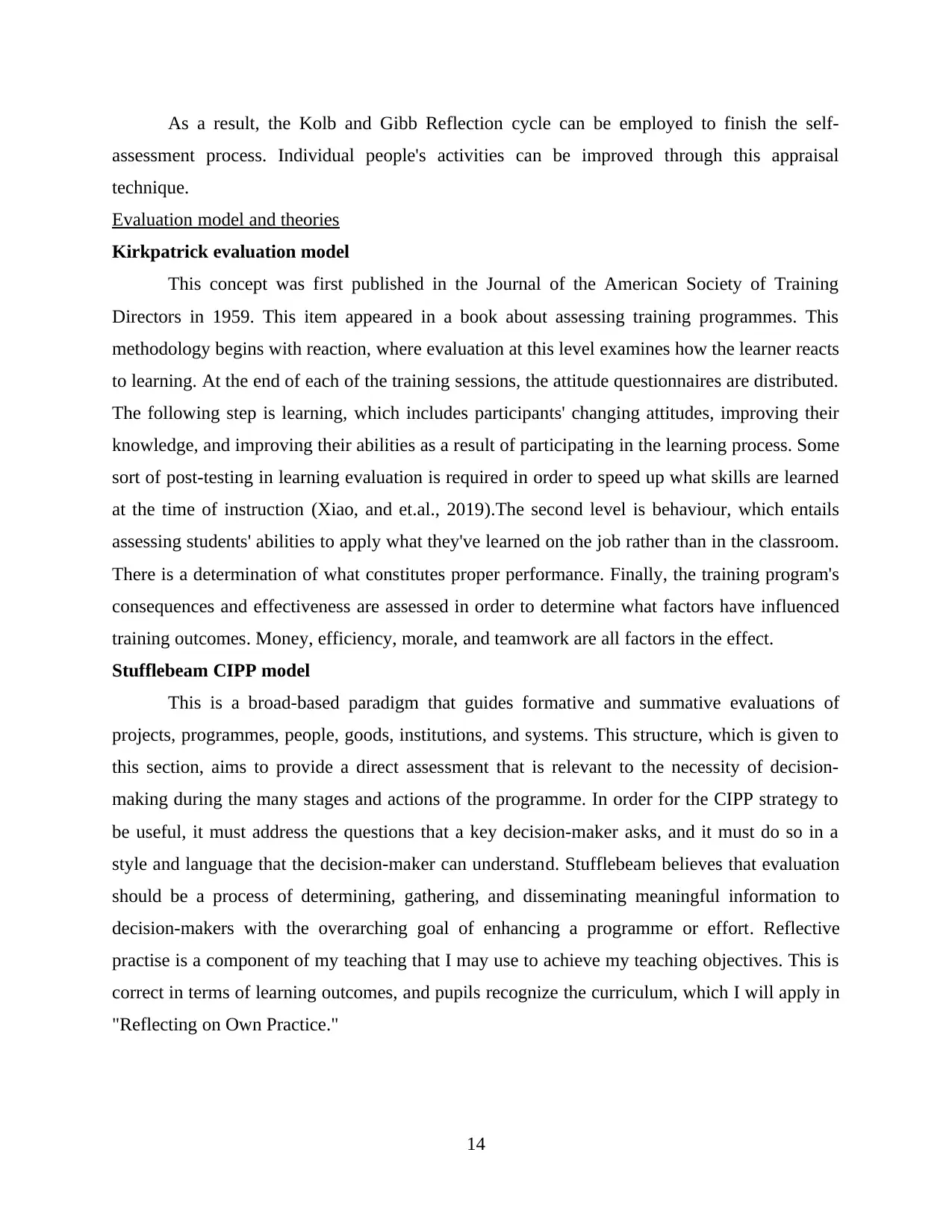
As a result, the Kolb and Gibb Reflection cycle can be employed to finish the self-
assessment process. Individual people's activities can be improved through this appraisal
technique.
Evaluation model and theories
Kirkpatrick evaluation model
This concept was first published in the Journal of the American Society of Training
Directors in 1959. This item appeared in a book about assessing training programmes. This
methodology begins with reaction, where evaluation at this level examines how the learner reacts
to learning. At the end of each of the training sessions, the attitude questionnaires are distributed.
The following step is learning, which includes participants' changing attitudes, improving their
knowledge, and improving their abilities as a result of participating in the learning process. Some
sort of post-testing in learning evaluation is required in order to speed up what skills are learned
at the time of instruction (Xiao, and et.al., 2019).The second level is behaviour, which entails
assessing students' abilities to apply what they've learned on the job rather than in the classroom.
There is a determination of what constitutes proper performance. Finally, the training program's
consequences and effectiveness are assessed in order to determine what factors have influenced
training outcomes. Money, efficiency, morale, and teamwork are all factors in the effect.
Stufflebeam CIPP model
This is a broad-based paradigm that guides formative and summative evaluations of
projects, programmes, people, goods, institutions, and systems. This structure, which is given to
this section, aims to provide a direct assessment that is relevant to the necessity of decision-
making during the many stages and actions of the programme. In order for the CIPP strategy to
be useful, it must address the questions that a key decision-maker asks, and it must do so in a
style and language that the decision-maker can understand. Stufflebeam believes that evaluation
should be a process of determining, gathering, and disseminating meaningful information to
decision-makers with the overarching goal of enhancing a programme or effort. Reflective
practise is a component of my teaching that I may use to achieve my teaching objectives. This is
correct in terms of learning outcomes, and pupils recognize the curriculum, which I will apply in
"Reflecting on Own Practice."
14
assessment process. Individual people's activities can be improved through this appraisal
technique.
Evaluation model and theories
Kirkpatrick evaluation model
This concept was first published in the Journal of the American Society of Training
Directors in 1959. This item appeared in a book about assessing training programmes. This
methodology begins with reaction, where evaluation at this level examines how the learner reacts
to learning. At the end of each of the training sessions, the attitude questionnaires are distributed.
The following step is learning, which includes participants' changing attitudes, improving their
knowledge, and improving their abilities as a result of participating in the learning process. Some
sort of post-testing in learning evaluation is required in order to speed up what skills are learned
at the time of instruction (Xiao, and et.al., 2019).The second level is behaviour, which entails
assessing students' abilities to apply what they've learned on the job rather than in the classroom.
There is a determination of what constitutes proper performance. Finally, the training program's
consequences and effectiveness are assessed in order to determine what factors have influenced
training outcomes. Money, efficiency, morale, and teamwork are all factors in the effect.
Stufflebeam CIPP model
This is a broad-based paradigm that guides formative and summative evaluations of
projects, programmes, people, goods, institutions, and systems. This structure, which is given to
this section, aims to provide a direct assessment that is relevant to the necessity of decision-
making during the many stages and actions of the programme. In order for the CIPP strategy to
be useful, it must address the questions that a key decision-maker asks, and it must do so in a
style and language that the decision-maker can understand. Stufflebeam believes that evaluation
should be a process of determining, gathering, and disseminating meaningful information to
decision-makers with the overarching goal of enhancing a programme or effort. Reflective
practise is a component of my teaching that I may use to achieve my teaching objectives. This is
correct in terms of learning outcomes, and pupils recognize the curriculum, which I will apply in
"Reflecting on Own Practice."
14
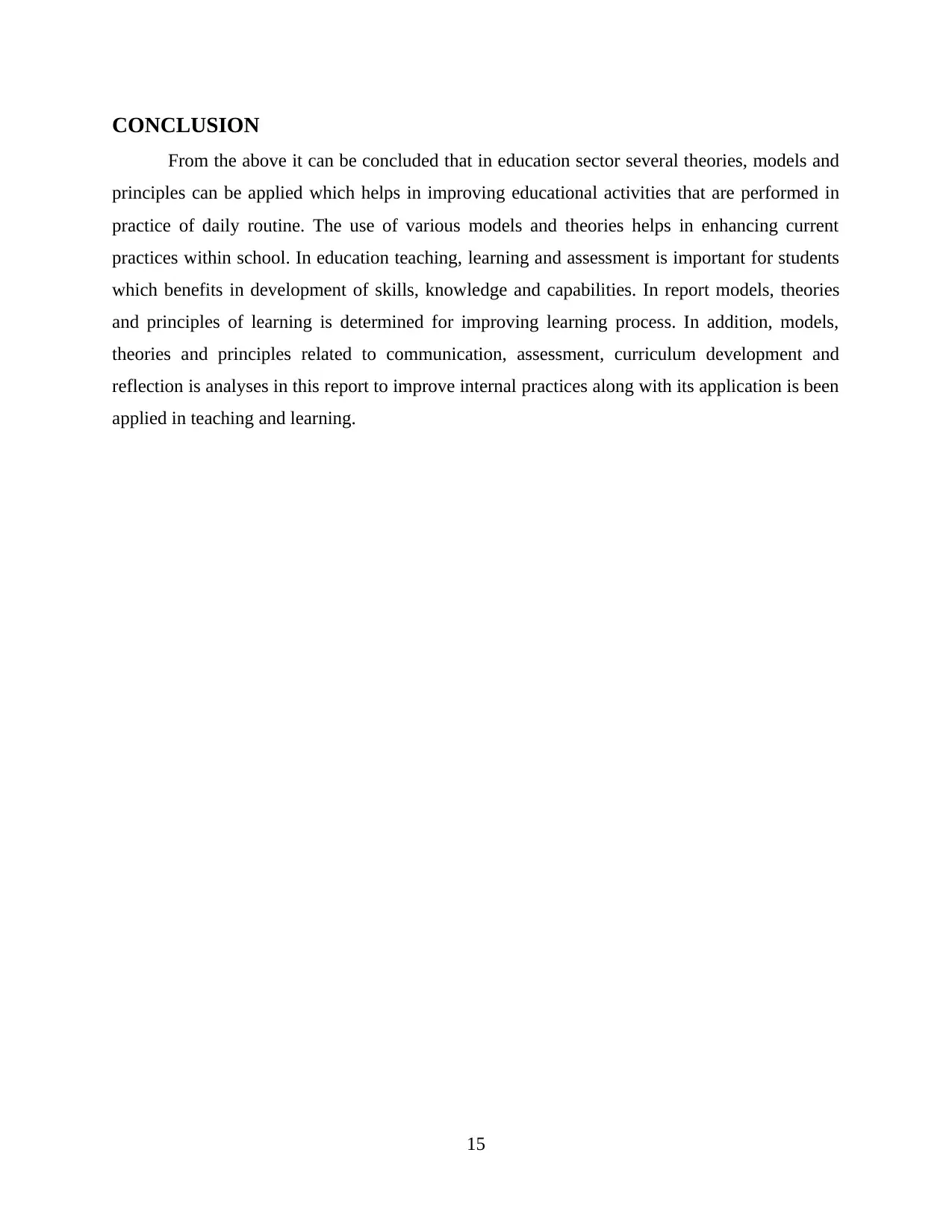
CONCLUSION
From the above it can be concluded that in education sector several theories, models and
principles can be applied which helps in improving educational activities that are performed in
practice of daily routine. The use of various models and theories helps in enhancing current
practices within school. In education teaching, learning and assessment is important for students
which benefits in development of skills, knowledge and capabilities. In report models, theories
and principles of learning is determined for improving learning process. In addition, models,
theories and principles related to communication, assessment, curriculum development and
reflection is analyses in this report to improve internal practices along with its application is been
applied in teaching and learning.
15
From the above it can be concluded that in education sector several theories, models and
principles can be applied which helps in improving educational activities that are performed in
practice of daily routine. The use of various models and theories helps in enhancing current
practices within school. In education teaching, learning and assessment is important for students
which benefits in development of skills, knowledge and capabilities. In report models, theories
and principles of learning is determined for improving learning process. In addition, models,
theories and principles related to communication, assessment, curriculum development and
reflection is analyses in this report to improve internal practices along with its application is been
applied in teaching and learning.
15
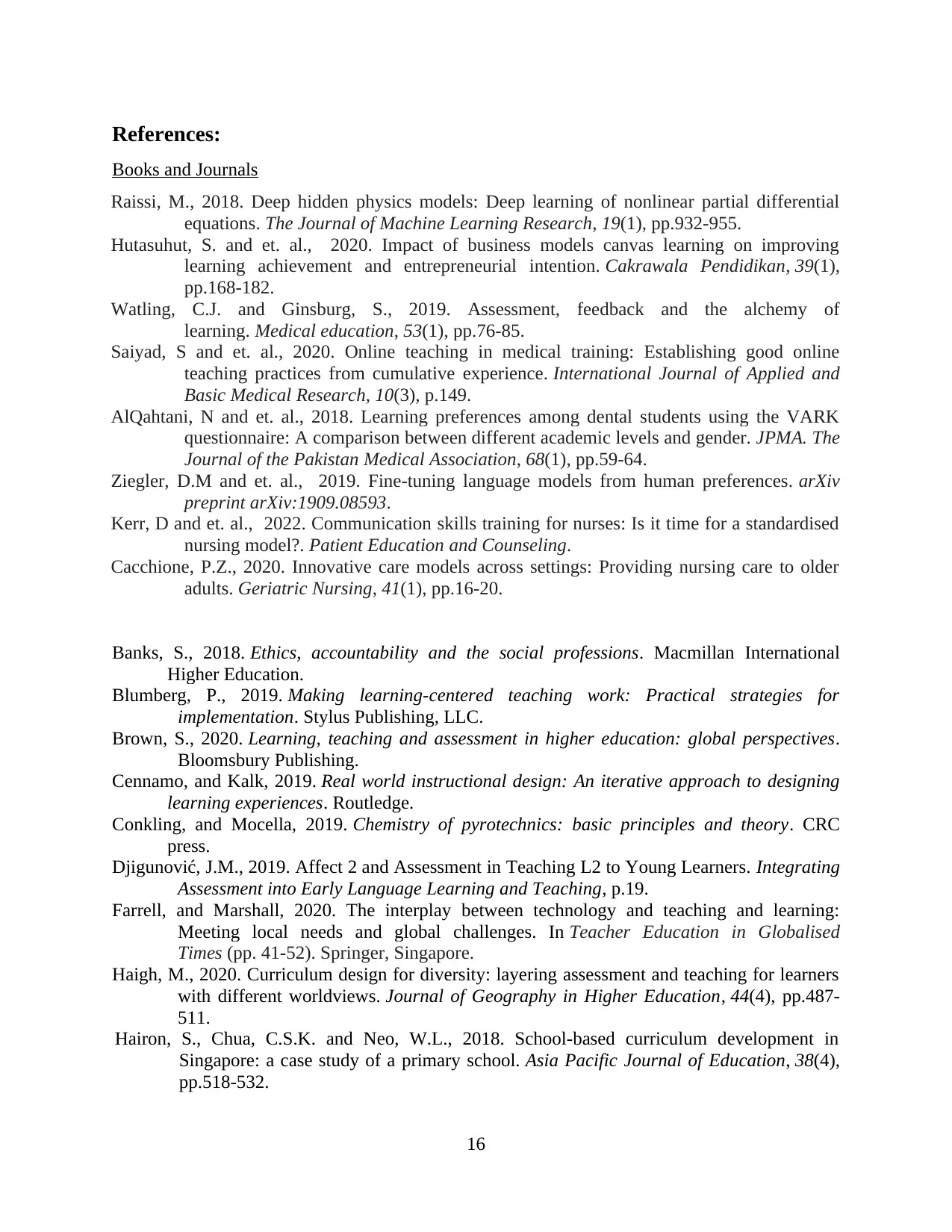
References:
Books and Journals
Raissi, M., 2018. Deep hidden physics models: Deep learning of nonlinear partial differential
equations. The Journal of Machine Learning Research, 19(1), pp.932-955.
Hutasuhut, S. and et. al., 2020. Impact of business models canvas learning on improving
learning achievement and entrepreneurial intention. Cakrawala Pendidikan, 39(1),
pp.168-182.
Watling, C.J. and Ginsburg, S., 2019. Assessment, feedback and the alchemy of
learning. Medical education, 53(1), pp.76-85.
Saiyad, S and et. al., 2020. Online teaching in medical training: Establishing good online
teaching practices from cumulative experience. International Journal of Applied and
Basic Medical Research, 10(3), p.149.
AlQahtani, N and et. al., 2018. Learning preferences among dental students using the VARK
questionnaire: A comparison between different academic levels and gender. JPMA. The
Journal of the Pakistan Medical Association, 68(1), pp.59-64.
Ziegler, D.M and et. al., 2019. Fine-tuning language models from human preferences. arXiv
preprint arXiv:1909.08593.
Kerr, D and et. al., 2022. Communication skills training for nurses: Is it time for a standardised
nursing model?. Patient Education and Counseling.
Cacchione, P.Z., 2020. Innovative care models across settings: Providing nursing care to older
adults. Geriatric Nursing, 41(1), pp.16-20.
Banks, S., 2018. Ethics, accountability and the social professions. Macmillan International
Higher Education.
Blumberg, P., 2019. Making learning-centered teaching work: Practical strategies for
implementation. Stylus Publishing, LLC.
Brown, S., 2020. Learning, teaching and assessment in higher education: global perspectives.
Bloomsbury Publishing.
Cennamo, and Kalk, 2019. Real world instructional design: An iterative approach to designing
learning experiences. Routledge.
Conkling, and Mocella, 2019. Chemistry of pyrotechnics: basic principles and theory. CRC
press.
Djigunović, J.M., 2019. Affect 2 and Assessment in Teaching L2 to Young Learners. Integrating
Assessment into Early Language Learning and Teaching, p.19.
Farrell, and Marshall, 2020. The interplay between technology and teaching and learning:
Meeting local needs and global challenges. In Teacher Education in Globalised
Times (pp. 41-52). Springer, Singapore.
Haigh, M., 2020. Curriculum design for diversity: layering assessment and teaching for learners
with different worldviews. Journal of Geography in Higher Education, 44(4), pp.487-
511.
Hairon, S., Chua, C.S.K. and Neo, W.L., 2018. School-based curriculum development in
Singapore: a case study of a primary school. Asia Pacific Journal of Education, 38(4),
pp.518-532.
16
Books and Journals
Raissi, M., 2018. Deep hidden physics models: Deep learning of nonlinear partial differential
equations. The Journal of Machine Learning Research, 19(1), pp.932-955.
Hutasuhut, S. and et. al., 2020. Impact of business models canvas learning on improving
learning achievement and entrepreneurial intention. Cakrawala Pendidikan, 39(1),
pp.168-182.
Watling, C.J. and Ginsburg, S., 2019. Assessment, feedback and the alchemy of
learning. Medical education, 53(1), pp.76-85.
Saiyad, S and et. al., 2020. Online teaching in medical training: Establishing good online
teaching practices from cumulative experience. International Journal of Applied and
Basic Medical Research, 10(3), p.149.
AlQahtani, N and et. al., 2018. Learning preferences among dental students using the VARK
questionnaire: A comparison between different academic levels and gender. JPMA. The
Journal of the Pakistan Medical Association, 68(1), pp.59-64.
Ziegler, D.M and et. al., 2019. Fine-tuning language models from human preferences. arXiv
preprint arXiv:1909.08593.
Kerr, D and et. al., 2022. Communication skills training for nurses: Is it time for a standardised
nursing model?. Patient Education and Counseling.
Cacchione, P.Z., 2020. Innovative care models across settings: Providing nursing care to older
adults. Geriatric Nursing, 41(1), pp.16-20.
Banks, S., 2018. Ethics, accountability and the social professions. Macmillan International
Higher Education.
Blumberg, P., 2019. Making learning-centered teaching work: Practical strategies for
implementation. Stylus Publishing, LLC.
Brown, S., 2020. Learning, teaching and assessment in higher education: global perspectives.
Bloomsbury Publishing.
Cennamo, and Kalk, 2019. Real world instructional design: An iterative approach to designing
learning experiences. Routledge.
Conkling, and Mocella, 2019. Chemistry of pyrotechnics: basic principles and theory. CRC
press.
Djigunović, J.M., 2019. Affect 2 and Assessment in Teaching L2 to Young Learners. Integrating
Assessment into Early Language Learning and Teaching, p.19.
Farrell, and Marshall, 2020. The interplay between technology and teaching and learning:
Meeting local needs and global challenges. In Teacher Education in Globalised
Times (pp. 41-52). Springer, Singapore.
Haigh, M., 2020. Curriculum design for diversity: layering assessment and teaching for learners
with different worldviews. Journal of Geography in Higher Education, 44(4), pp.487-
511.
Hairon, S., Chua, C.S.K. and Neo, W.L., 2018. School-based curriculum development in
Singapore: a case study of a primary school. Asia Pacific Journal of Education, 38(4),
pp.518-532.
16
Paraphrase This Document
Need a fresh take? Get an instant paraphrase of this document with our AI Paraphraser
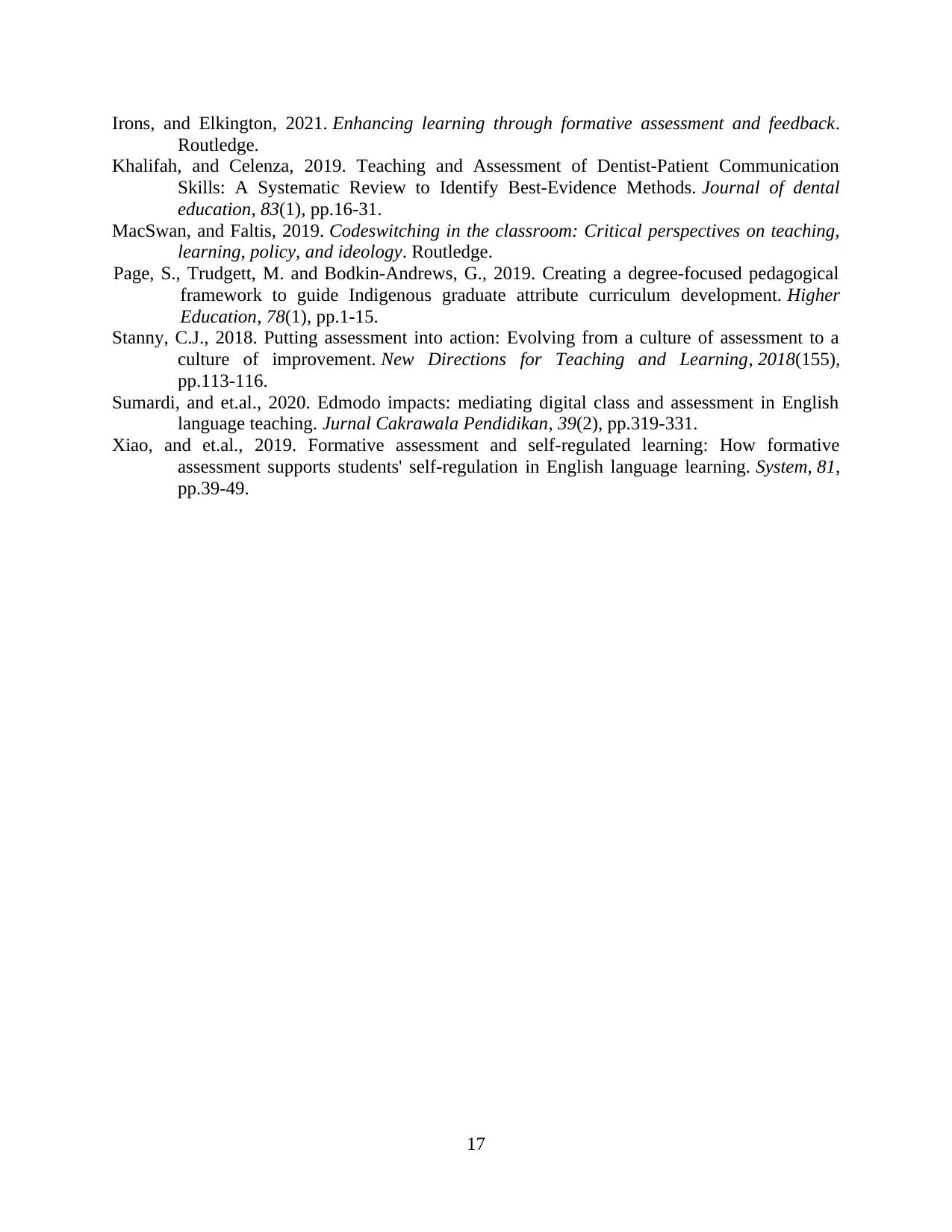
Irons, and Elkington, 2021. Enhancing learning through formative assessment and feedback.
Routledge.
Khalifah, and Celenza, 2019. Teaching and Assessment of Dentist‐Patient Communication
Skills: A Systematic Review to Identify Best‐Evidence Methods. Journal of dental
education, 83(1), pp.16-31.
MacSwan, and Faltis, 2019. Codeswitching in the classroom: Critical perspectives on teaching,
learning, policy, and ideology. Routledge.
Page, S., Trudgett, M. and Bodkin-Andrews, G., 2019. Creating a degree-focused pedagogical
framework to guide Indigenous graduate attribute curriculum development. Higher
Education, 78(1), pp.1-15.
Stanny, C.J., 2018. Putting assessment into action: Evolving from a culture of assessment to a
culture of improvement. New Directions for Teaching and Learning, 2018(155),
pp.113-116.
Sumardi, and et.al., 2020. Edmodo impacts: mediating digital class and assessment in English
language teaching. Jurnal Cakrawala Pendidikan, 39(2), pp.319-331.
Xiao, and et.al., 2019. Formative assessment and self-regulated learning: How formative
assessment supports students' self-regulation in English language learning. System, 81,
pp.39-49.
17
Routledge.
Khalifah, and Celenza, 2019. Teaching and Assessment of Dentist‐Patient Communication
Skills: A Systematic Review to Identify Best‐Evidence Methods. Journal of dental
education, 83(1), pp.16-31.
MacSwan, and Faltis, 2019. Codeswitching in the classroom: Critical perspectives on teaching,
learning, policy, and ideology. Routledge.
Page, S., Trudgett, M. and Bodkin-Andrews, G., 2019. Creating a degree-focused pedagogical
framework to guide Indigenous graduate attribute curriculum development. Higher
Education, 78(1), pp.1-15.
Stanny, C.J., 2018. Putting assessment into action: Evolving from a culture of assessment to a
culture of improvement. New Directions for Teaching and Learning, 2018(155),
pp.113-116.
Sumardi, and et.al., 2020. Edmodo impacts: mediating digital class and assessment in English
language teaching. Jurnal Cakrawala Pendidikan, 39(2), pp.319-331.
Xiao, and et.al., 2019. Formative assessment and self-regulated learning: How formative
assessment supports students' self-regulation in English language learning. System, 81,
pp.39-49.
17
1 out of 20
Related Documents
Your All-in-One AI-Powered Toolkit for Academic Success.
+13062052269
info@desklib.com
Available 24*7 on WhatsApp / Email
![[object Object]](/_next/static/media/star-bottom.7253800d.svg)
Unlock your academic potential
© 2024 | Zucol Services PVT LTD | All rights reserved.

